Leading Innovation and change Assignment
VerifiedAdded on 2021/06/17
|24
|5732
|349
AI Summary
Contribute Materials
Your contribution can guide someone’s learning journey. Share your
documents today.
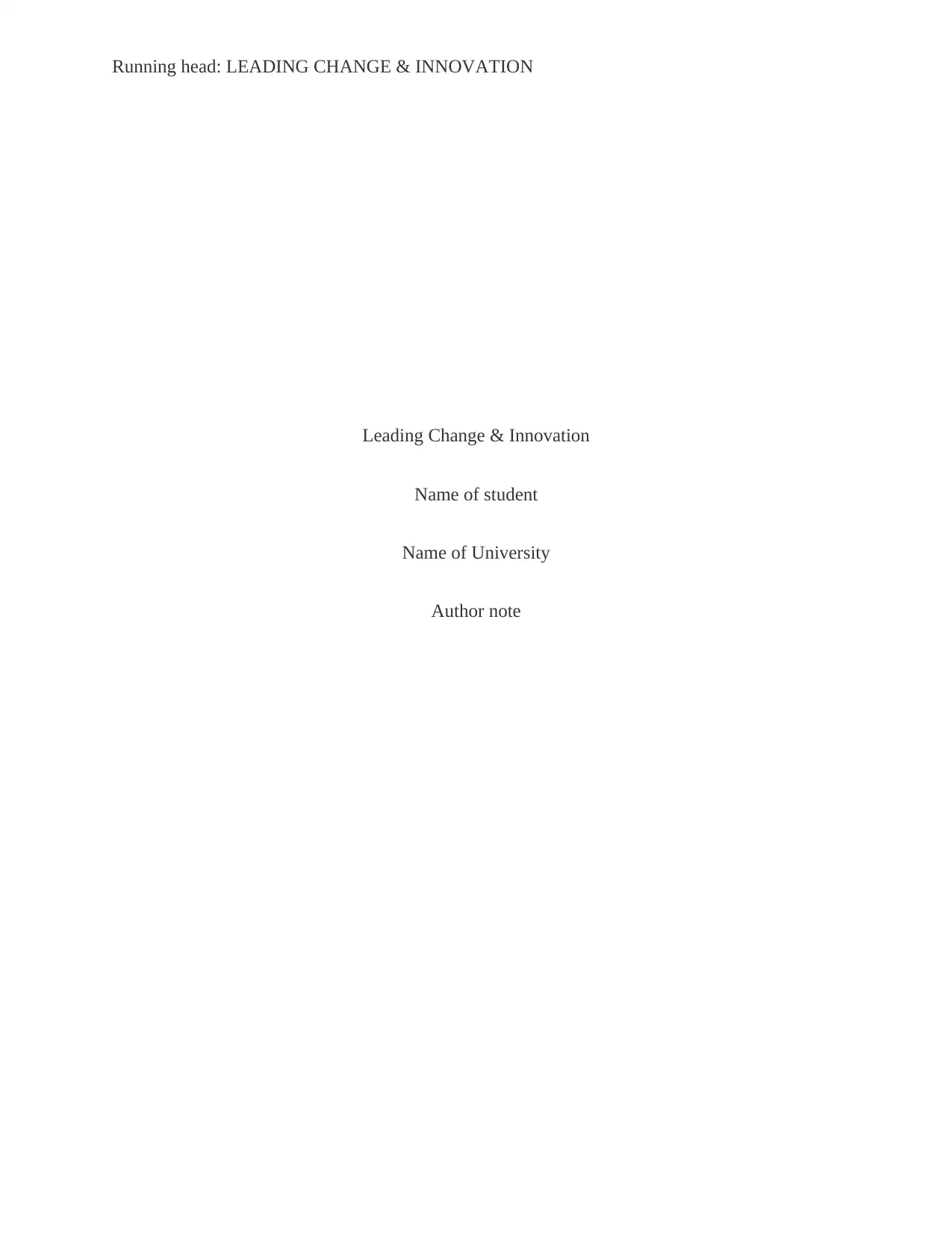
Running head: LEADING CHANGE & INNOVATION
Leading Change & Innovation
Name of student
Name of University
Author note
Leading Change & Innovation
Name of student
Name of University
Author note
Secure Best Marks with AI Grader
Need help grading? Try our AI Grader for instant feedback on your assignments.
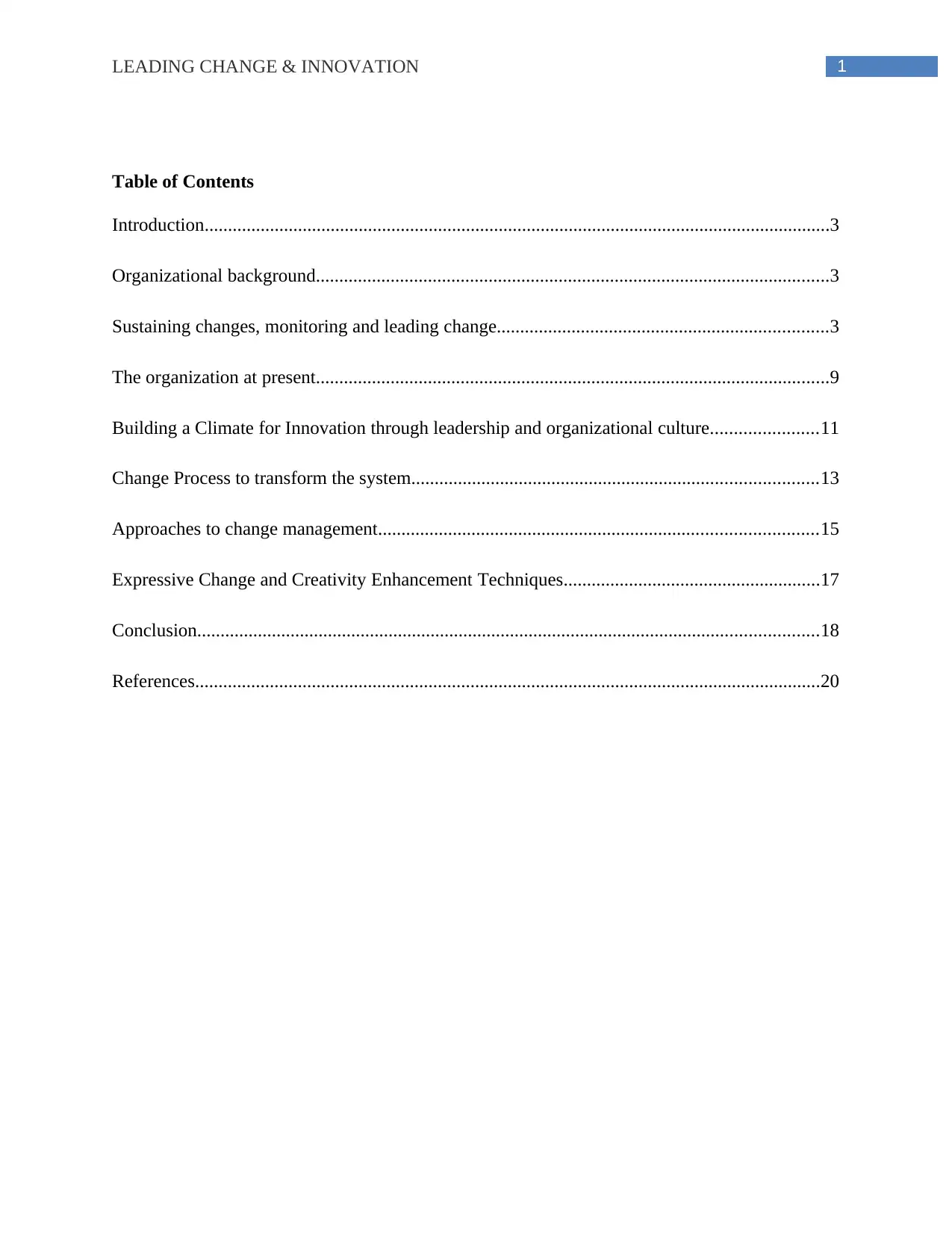
1LEADING CHANGE & INNOVATION
Table of Contents
Introduction......................................................................................................................................3
Organizational background..............................................................................................................3
Sustaining changes, monitoring and leading change.......................................................................3
The organization at present..............................................................................................................9
Building a Climate for Innovation through leadership and organizational culture.......................11
Change Process to transform the system.......................................................................................13
Approaches to change management..............................................................................................15
Expressive Change and Creativity Enhancement Techniques.......................................................17
Conclusion.....................................................................................................................................18
References......................................................................................................................................20
Table of Contents
Introduction......................................................................................................................................3
Organizational background..............................................................................................................3
Sustaining changes, monitoring and leading change.......................................................................3
The organization at present..............................................................................................................9
Building a Climate for Innovation through leadership and organizational culture.......................11
Change Process to transform the system.......................................................................................13
Approaches to change management..............................................................................................15
Expressive Change and Creativity Enhancement Techniques.......................................................17
Conclusion.....................................................................................................................................18
References......................................................................................................................................20
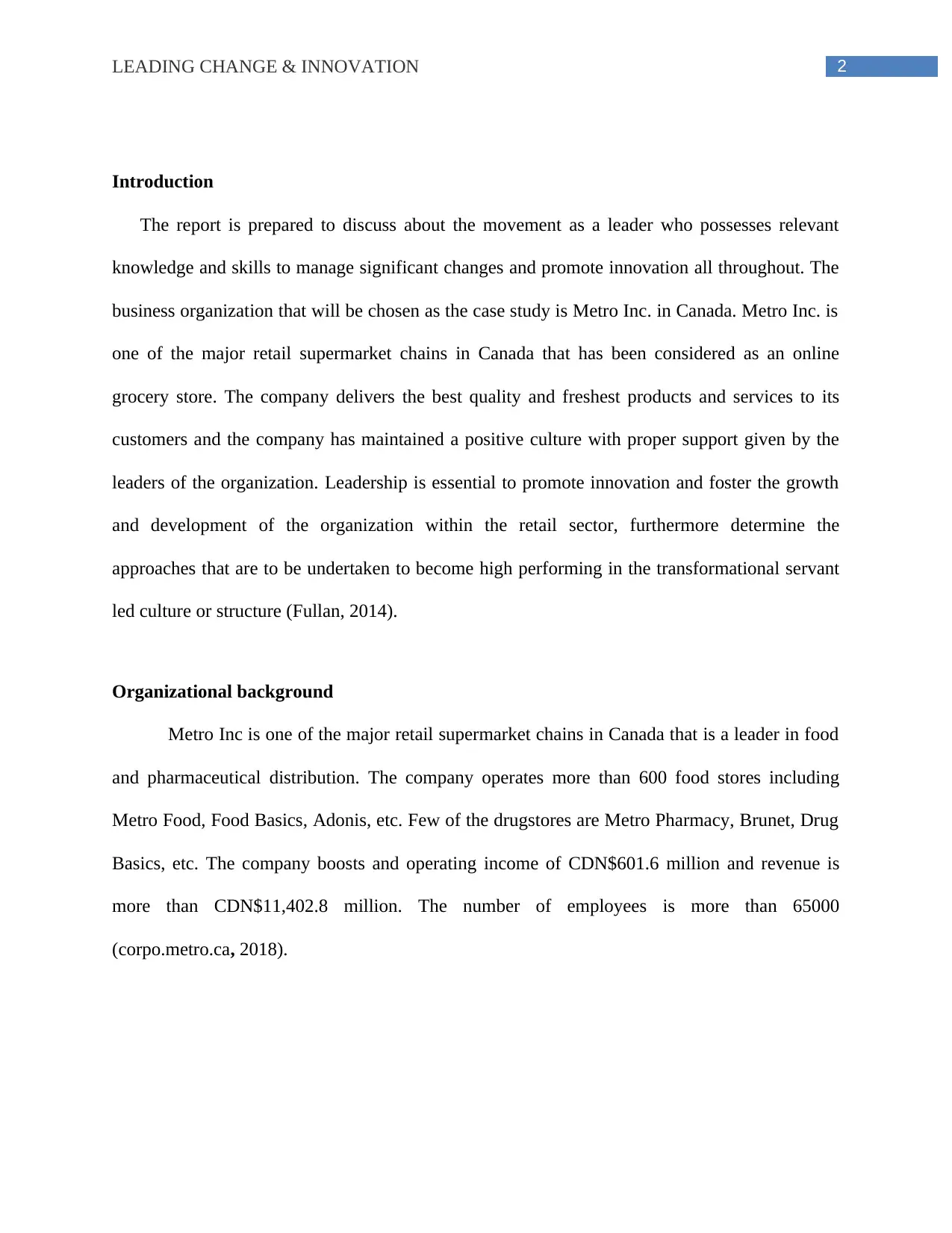
2LEADING CHANGE & INNOVATION
Introduction
The report is prepared to discuss about the movement as a leader who possesses relevant
knowledge and skills to manage significant changes and promote innovation all throughout. The
business organization that will be chosen as the case study is Metro Inc. in Canada. Metro Inc. is
one of the major retail supermarket chains in Canada that has been considered as an online
grocery store. The company delivers the best quality and freshest products and services to its
customers and the company has maintained a positive culture with proper support given by the
leaders of the organization. Leadership is essential to promote innovation and foster the growth
and development of the organization within the retail sector, furthermore determine the
approaches that are to be undertaken to become high performing in the transformational servant
led culture or structure (Fullan, 2014).
Organizational background
Metro Inc is one of the major retail supermarket chains in Canada that is a leader in food
and pharmaceutical distribution. The company operates more than 600 food stores including
Metro Food, Food Basics, Adonis, etc. Few of the drugstores are Metro Pharmacy, Brunet, Drug
Basics, etc. The company boosts and operating income of CDN$601.6 million and revenue is
more than CDN$11,402.8 million. The number of employees is more than 65000
(corpo.metro.ca, 2018).
Introduction
The report is prepared to discuss about the movement as a leader who possesses relevant
knowledge and skills to manage significant changes and promote innovation all throughout. The
business organization that will be chosen as the case study is Metro Inc. in Canada. Metro Inc. is
one of the major retail supermarket chains in Canada that has been considered as an online
grocery store. The company delivers the best quality and freshest products and services to its
customers and the company has maintained a positive culture with proper support given by the
leaders of the organization. Leadership is essential to promote innovation and foster the growth
and development of the organization within the retail sector, furthermore determine the
approaches that are to be undertaken to become high performing in the transformational servant
led culture or structure (Fullan, 2014).
Organizational background
Metro Inc is one of the major retail supermarket chains in Canada that is a leader in food
and pharmaceutical distribution. The company operates more than 600 food stores including
Metro Food, Food Basics, Adonis, etc. Few of the drugstores are Metro Pharmacy, Brunet, Drug
Basics, etc. The company boosts and operating income of CDN$601.6 million and revenue is
more than CDN$11,402.8 million. The number of employees is more than 65000
(corpo.metro.ca, 2018).
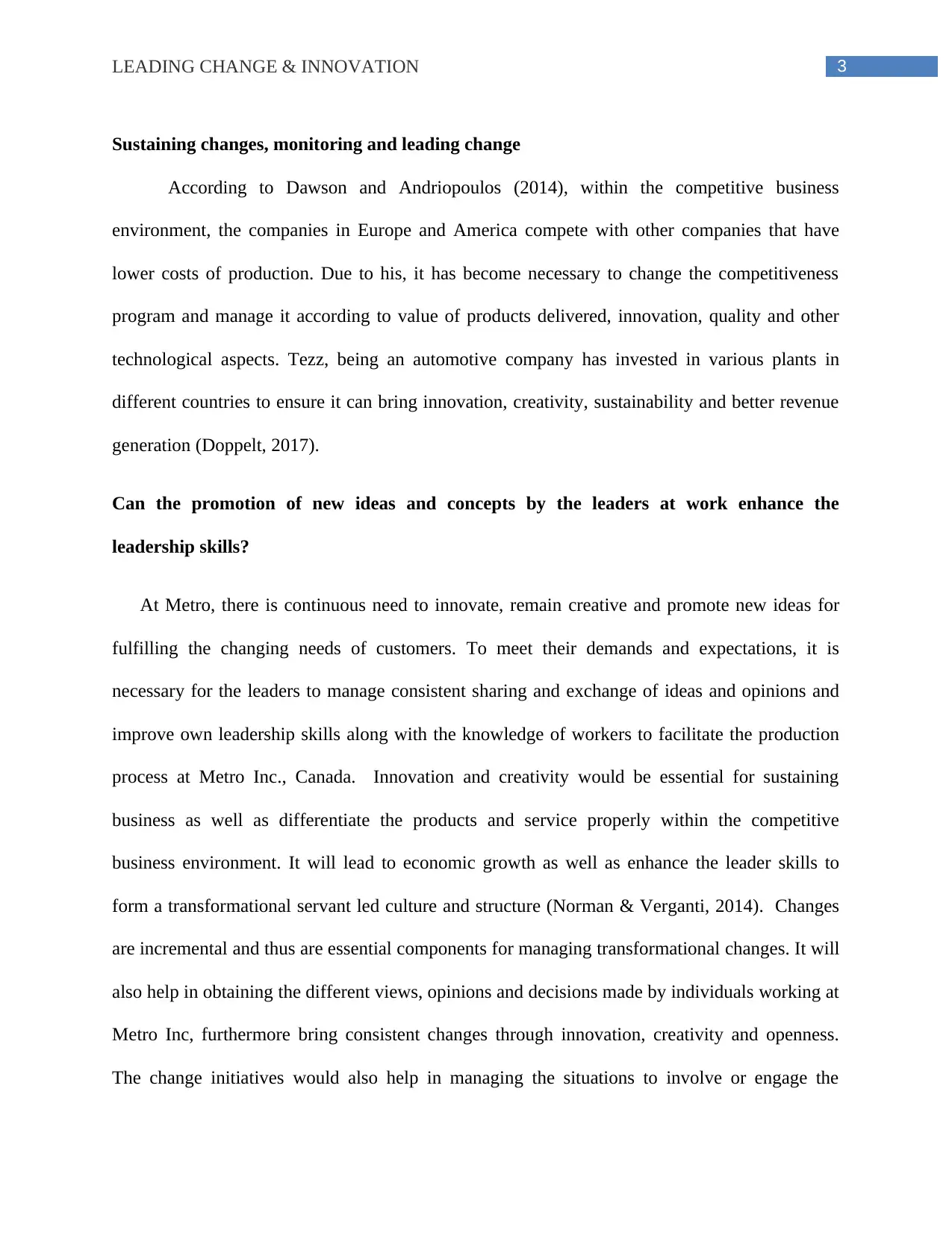
3LEADING CHANGE & INNOVATION
Sustaining changes, monitoring and leading change
According to Dawson and Andriopoulos (2014), within the competitive business
environment, the companies in Europe and America compete with other companies that have
lower costs of production. Due to his, it has become necessary to change the competitiveness
program and manage it according to value of products delivered, innovation, quality and other
technological aspects. Tezz, being an automotive company has invested in various plants in
different countries to ensure it can bring innovation, creativity, sustainability and better revenue
generation (Doppelt, 2017).
Can the promotion of new ideas and concepts by the leaders at work enhance the
leadership skills?
At Metro, there is continuous need to innovate, remain creative and promote new ideas for
fulfilling the changing needs of customers. To meet their demands and expectations, it is
necessary for the leaders to manage consistent sharing and exchange of ideas and opinions and
improve own leadership skills along with the knowledge of workers to facilitate the production
process at Metro Inc., Canada. Innovation and creativity would be essential for sustaining
business as well as differentiate the products and service properly within the competitive
business environment. It will lead to economic growth as well as enhance the leader skills to
form a transformational servant led culture and structure (Norman & Verganti, 2014). Changes
are incremental and thus are essential components for managing transformational changes. It will
also help in obtaining the different views, opinions and decisions made by individuals working at
Metro Inc, furthermore bring consistent changes through innovation, creativity and openness.
The change initiatives would also help in managing the situations to involve or engage the
Sustaining changes, monitoring and leading change
According to Dawson and Andriopoulos (2014), within the competitive business
environment, the companies in Europe and America compete with other companies that have
lower costs of production. Due to his, it has become necessary to change the competitiveness
program and manage it according to value of products delivered, innovation, quality and other
technological aspects. Tezz, being an automotive company has invested in various plants in
different countries to ensure it can bring innovation, creativity, sustainability and better revenue
generation (Doppelt, 2017).
Can the promotion of new ideas and concepts by the leaders at work enhance the
leadership skills?
At Metro, there is continuous need to innovate, remain creative and promote new ideas for
fulfilling the changing needs of customers. To meet their demands and expectations, it is
necessary for the leaders to manage consistent sharing and exchange of ideas and opinions and
improve own leadership skills along with the knowledge of workers to facilitate the production
process at Metro Inc., Canada. Innovation and creativity would be essential for sustaining
business as well as differentiate the products and service properly within the competitive
business environment. It will lead to economic growth as well as enhance the leader skills to
form a transformational servant led culture and structure (Norman & Verganti, 2014). Changes
are incremental and thus are essential components for managing transformational changes. It will
also help in obtaining the different views, opinions and decisions made by individuals working at
Metro Inc, furthermore bring consistent changes through innovation, creativity and openness.
The change initiatives would also help in managing the situations to involve or engage the
Secure Best Marks with AI Grader
Need help grading? Try our AI Grader for instant feedback on your assignments.
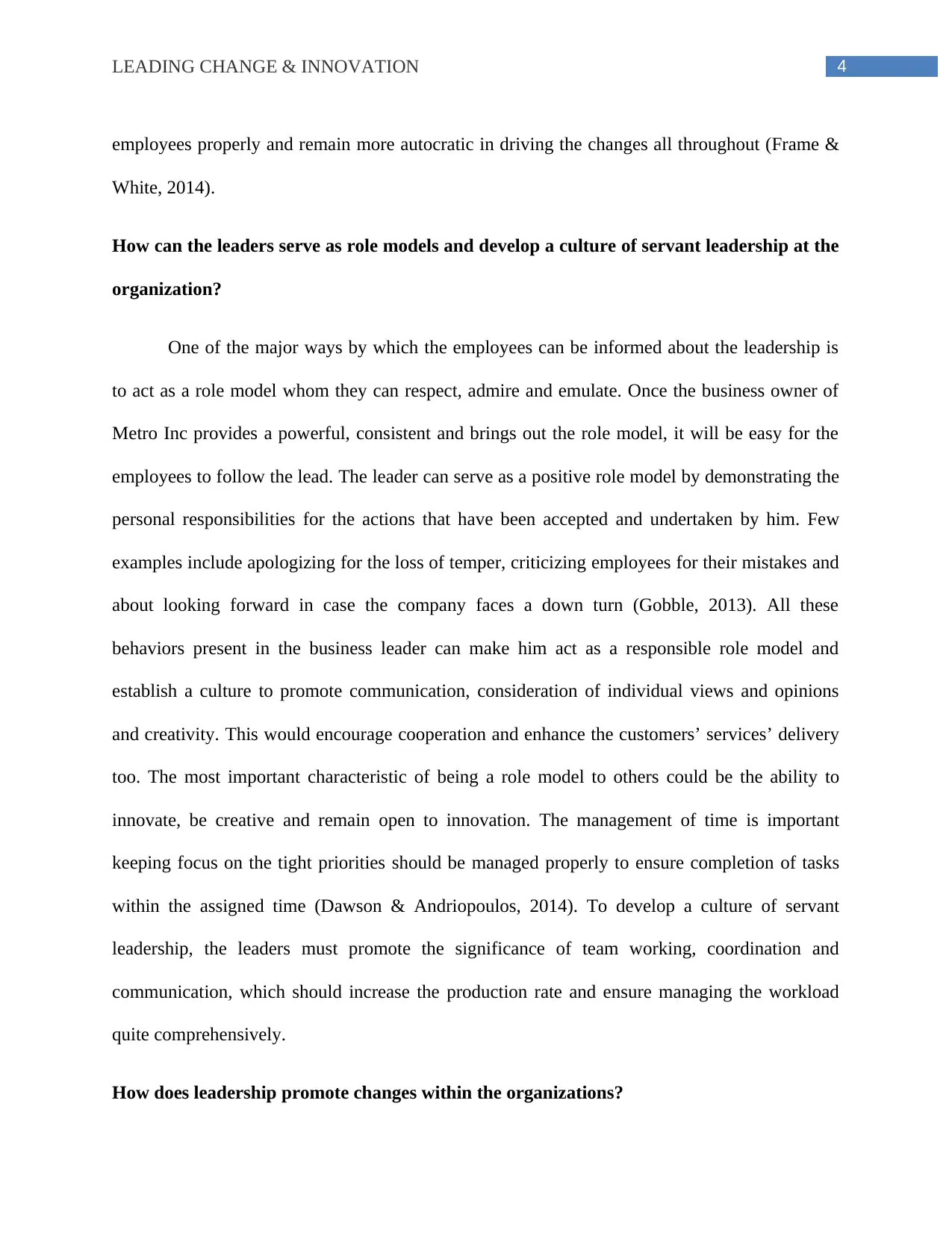
4LEADING CHANGE & INNOVATION
employees properly and remain more autocratic in driving the changes all throughout (Frame &
White, 2014).
How can the leaders serve as role models and develop a culture of servant leadership at the
organization?
One of the major ways by which the employees can be informed about the leadership is
to act as a role model whom they can respect, admire and emulate. Once the business owner of
Metro Inc provides a powerful, consistent and brings out the role model, it will be easy for the
employees to follow the lead. The leader can serve as a positive role model by demonstrating the
personal responsibilities for the actions that have been accepted and undertaken by him. Few
examples include apologizing for the loss of temper, criticizing employees for their mistakes and
about looking forward in case the company faces a down turn (Gobble, 2013). All these
behaviors present in the business leader can make him act as a responsible role model and
establish a culture to promote communication, consideration of individual views and opinions
and creativity. This would encourage cooperation and enhance the customers’ services’ delivery
too. The most important characteristic of being a role model to others could be the ability to
innovate, be creative and remain open to innovation. The management of time is important
keeping focus on the tight priorities should be managed properly to ensure completion of tasks
within the assigned time (Dawson & Andriopoulos, 2014). To develop a culture of servant
leadership, the leaders must promote the significance of team working, coordination and
communication, which should increase the production rate and ensure managing the workload
quite comprehensively.
How does leadership promote changes within the organizations?
employees properly and remain more autocratic in driving the changes all throughout (Frame &
White, 2014).
How can the leaders serve as role models and develop a culture of servant leadership at the
organization?
One of the major ways by which the employees can be informed about the leadership is
to act as a role model whom they can respect, admire and emulate. Once the business owner of
Metro Inc provides a powerful, consistent and brings out the role model, it will be easy for the
employees to follow the lead. The leader can serve as a positive role model by demonstrating the
personal responsibilities for the actions that have been accepted and undertaken by him. Few
examples include apologizing for the loss of temper, criticizing employees for their mistakes and
about looking forward in case the company faces a down turn (Gobble, 2013). All these
behaviors present in the business leader can make him act as a responsible role model and
establish a culture to promote communication, consideration of individual views and opinions
and creativity. This would encourage cooperation and enhance the customers’ services’ delivery
too. The most important characteristic of being a role model to others could be the ability to
innovate, be creative and remain open to innovation. The management of time is important
keeping focus on the tight priorities should be managed properly to ensure completion of tasks
within the assigned time (Dawson & Andriopoulos, 2014). To develop a culture of servant
leadership, the leaders must promote the significance of team working, coordination and
communication, which should increase the production rate and ensure managing the workload
quite comprehensively.
How does leadership promote changes within the organizations?
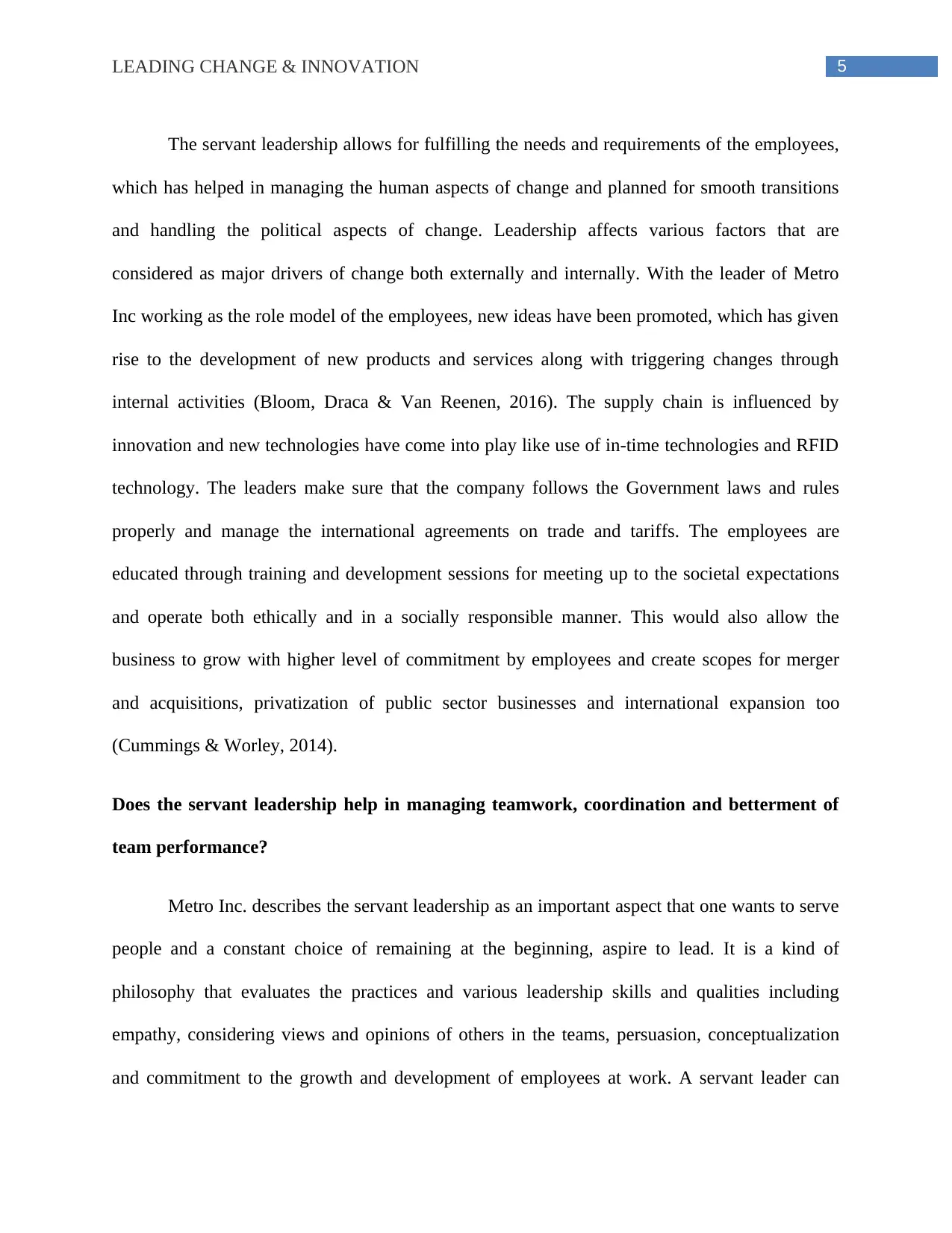
5LEADING CHANGE & INNOVATION
The servant leadership allows for fulfilling the needs and requirements of the employees,
which has helped in managing the human aspects of change and planned for smooth transitions
and handling the political aspects of change. Leadership affects various factors that are
considered as major drivers of change both externally and internally. With the leader of Metro
Inc working as the role model of the employees, new ideas have been promoted, which has given
rise to the development of new products and services along with triggering changes through
internal activities (Bloom, Draca & Van Reenen, 2016). The supply chain is influenced by
innovation and new technologies have come into play like use of in-time technologies and RFID
technology. The leaders make sure that the company follows the Government laws and rules
properly and manage the international agreements on trade and tariffs. The employees are
educated through training and development sessions for meeting up to the societal expectations
and operate both ethically and in a socially responsible manner. This would also allow the
business to grow with higher level of commitment by employees and create scopes for merger
and acquisitions, privatization of public sector businesses and international expansion too
(Cummings & Worley, 2014).
Does the servant leadership help in managing teamwork, coordination and betterment of
team performance?
Metro Inc. describes the servant leadership as an important aspect that one wants to serve
people and a constant choice of remaining at the beginning, aspire to lead. It is a kind of
philosophy that evaluates the practices and various leadership skills and qualities including
empathy, considering views and opinions of others in the teams, persuasion, conceptualization
and commitment to the growth and development of employees at work. A servant leader can
The servant leadership allows for fulfilling the needs and requirements of the employees,
which has helped in managing the human aspects of change and planned for smooth transitions
and handling the political aspects of change. Leadership affects various factors that are
considered as major drivers of change both externally and internally. With the leader of Metro
Inc working as the role model of the employees, new ideas have been promoted, which has given
rise to the development of new products and services along with triggering changes through
internal activities (Bloom, Draca & Van Reenen, 2016). The supply chain is influenced by
innovation and new technologies have come into play like use of in-time technologies and RFID
technology. The leaders make sure that the company follows the Government laws and rules
properly and manage the international agreements on trade and tariffs. The employees are
educated through training and development sessions for meeting up to the societal expectations
and operate both ethically and in a socially responsible manner. This would also allow the
business to grow with higher level of commitment by employees and create scopes for merger
and acquisitions, privatization of public sector businesses and international expansion too
(Cummings & Worley, 2014).
Does the servant leadership help in managing teamwork, coordination and betterment of
team performance?
Metro Inc. describes the servant leadership as an important aspect that one wants to serve
people and a constant choice of remaining at the beginning, aspire to lead. It is a kind of
philosophy that evaluates the practices and various leadership skills and qualities including
empathy, considering views and opinions of others in the teams, persuasion, conceptualization
and commitment to the growth and development of employees at work. A servant leader can
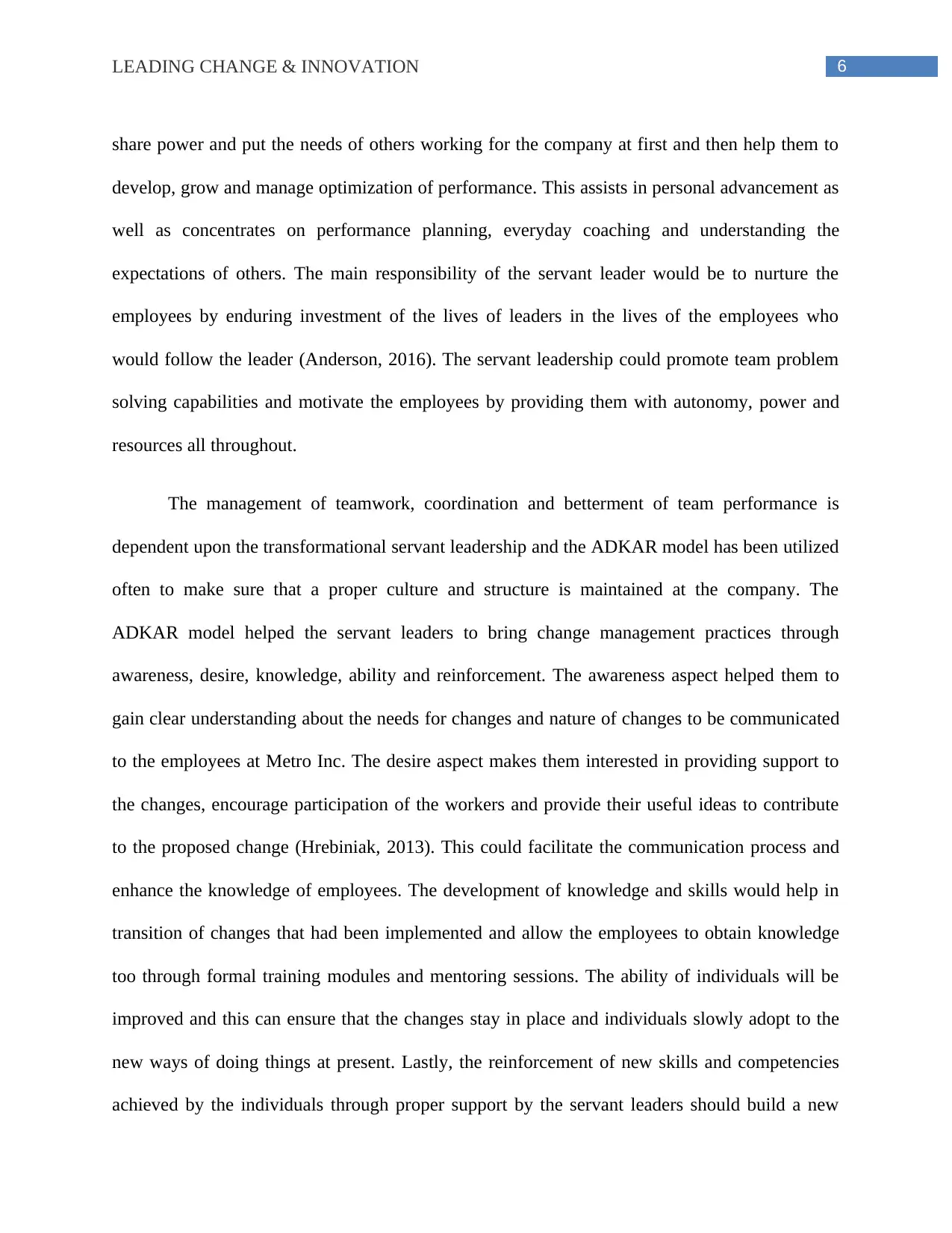
6LEADING CHANGE & INNOVATION
share power and put the needs of others working for the company at first and then help them to
develop, grow and manage optimization of performance. This assists in personal advancement as
well as concentrates on performance planning, everyday coaching and understanding the
expectations of others. The main responsibility of the servant leader would be to nurture the
employees by enduring investment of the lives of leaders in the lives of the employees who
would follow the leader (Anderson, 2016). The servant leadership could promote team problem
solving capabilities and motivate the employees by providing them with autonomy, power and
resources all throughout.
The management of teamwork, coordination and betterment of team performance is
dependent upon the transformational servant leadership and the ADKAR model has been utilized
often to make sure that a proper culture and structure is maintained at the company. The
ADKAR model helped the servant leaders to bring change management practices through
awareness, desire, knowledge, ability and reinforcement. The awareness aspect helped them to
gain clear understanding about the needs for changes and nature of changes to be communicated
to the employees at Metro Inc. The desire aspect makes them interested in providing support to
the changes, encourage participation of the workers and provide their useful ideas to contribute
to the proposed change (Hrebiniak, 2013). This could facilitate the communication process and
enhance the knowledge of employees. The development of knowledge and skills would help in
transition of changes that had been implemented and allow the employees to obtain knowledge
too through formal training modules and mentoring sessions. The ability of individuals will be
improved and this can ensure that the changes stay in place and individuals slowly adopt to the
new ways of doing things at present. Lastly, the reinforcement of new skills and competencies
achieved by the individuals through proper support by the servant leaders should build a new
share power and put the needs of others working for the company at first and then help them to
develop, grow and manage optimization of performance. This assists in personal advancement as
well as concentrates on performance planning, everyday coaching and understanding the
expectations of others. The main responsibility of the servant leader would be to nurture the
employees by enduring investment of the lives of leaders in the lives of the employees who
would follow the leader (Anderson, 2016). The servant leadership could promote team problem
solving capabilities and motivate the employees by providing them with autonomy, power and
resources all throughout.
The management of teamwork, coordination and betterment of team performance is
dependent upon the transformational servant leadership and the ADKAR model has been utilized
often to make sure that a proper culture and structure is maintained at the company. The
ADKAR model helped the servant leaders to bring change management practices through
awareness, desire, knowledge, ability and reinforcement. The awareness aspect helped them to
gain clear understanding about the needs for changes and nature of changes to be communicated
to the employees at Metro Inc. The desire aspect makes them interested in providing support to
the changes, encourage participation of the workers and provide their useful ideas to contribute
to the proposed change (Hrebiniak, 2013). This could facilitate the communication process and
enhance the knowledge of employees. The development of knowledge and skills would help in
transition of changes that had been implemented and allow the employees to obtain knowledge
too through formal training modules and mentoring sessions. The ability of individuals will be
improved and this can ensure that the changes stay in place and individuals slowly adopt to the
new ways of doing things at present. Lastly, the reinforcement of new skills and competencies
achieved by the individuals through proper support by the servant leaders should build a new
Paraphrase This Document
Need a fresh take? Get an instant paraphrase of this document with our AI Paraphraser
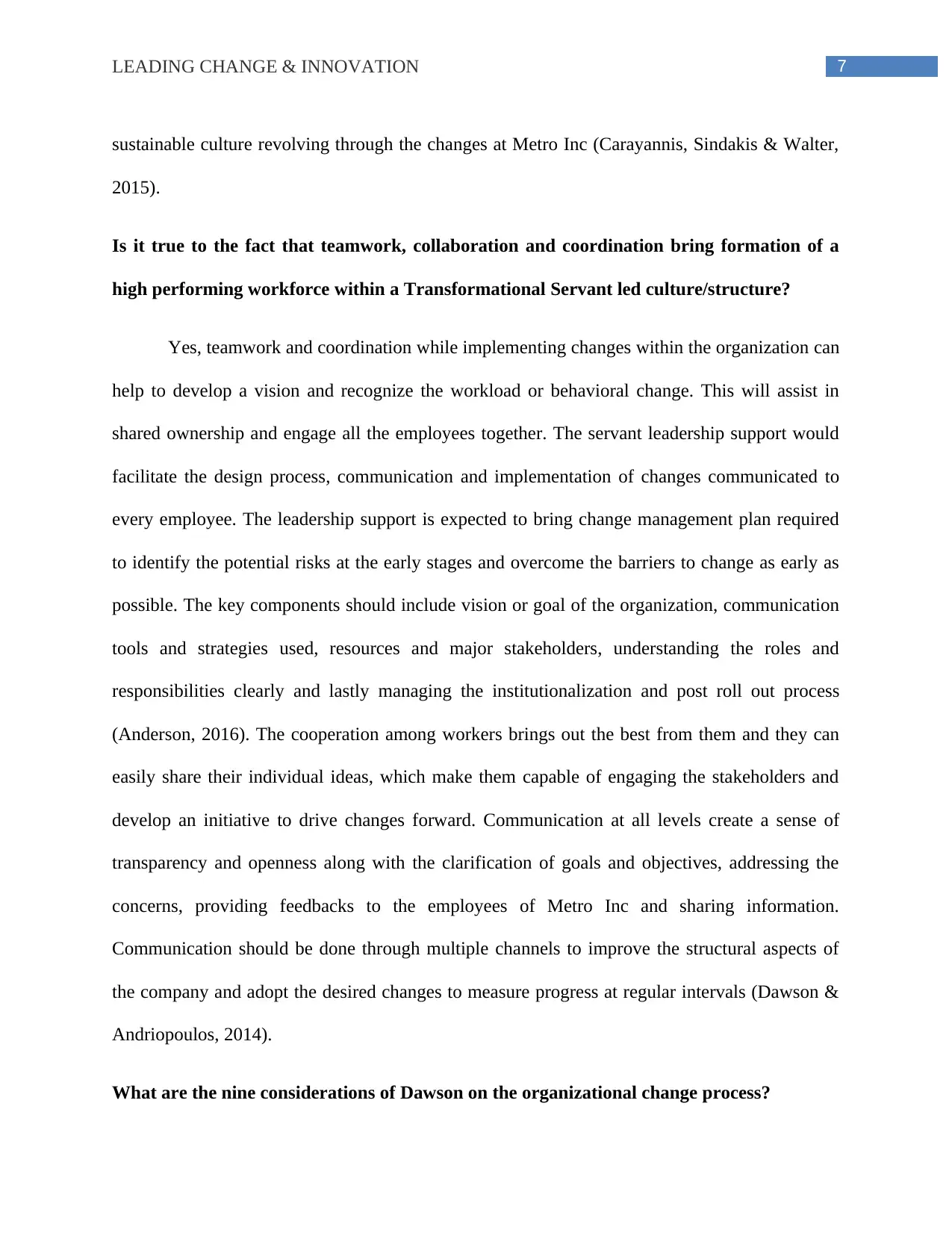
7LEADING CHANGE & INNOVATION
sustainable culture revolving through the changes at Metro Inc (Carayannis, Sindakis & Walter,
2015).
Is it true to the fact that teamwork, collaboration and coordination bring formation of a
high performing workforce within a Transformational Servant led culture/structure?
Yes, teamwork and coordination while implementing changes within the organization can
help to develop a vision and recognize the workload or behavioral change. This will assist in
shared ownership and engage all the employees together. The servant leadership support would
facilitate the design process, communication and implementation of changes communicated to
every employee. The leadership support is expected to bring change management plan required
to identify the potential risks at the early stages and overcome the barriers to change as early as
possible. The key components should include vision or goal of the organization, communication
tools and strategies used, resources and major stakeholders, understanding the roles and
responsibilities clearly and lastly managing the institutionalization and post roll out process
(Anderson, 2016). The cooperation among workers brings out the best from them and they can
easily share their individual ideas, which make them capable of engaging the stakeholders and
develop an initiative to drive changes forward. Communication at all levels create a sense of
transparency and openness along with the clarification of goals and objectives, addressing the
concerns, providing feedbacks to the employees of Metro Inc and sharing information.
Communication should be done through multiple channels to improve the structural aspects of
the company and adopt the desired changes to measure progress at regular intervals (Dawson &
Andriopoulos, 2014).
What are the nine considerations of Dawson on the organizational change process?
sustainable culture revolving through the changes at Metro Inc (Carayannis, Sindakis & Walter,
2015).
Is it true to the fact that teamwork, collaboration and coordination bring formation of a
high performing workforce within a Transformational Servant led culture/structure?
Yes, teamwork and coordination while implementing changes within the organization can
help to develop a vision and recognize the workload or behavioral change. This will assist in
shared ownership and engage all the employees together. The servant leadership support would
facilitate the design process, communication and implementation of changes communicated to
every employee. The leadership support is expected to bring change management plan required
to identify the potential risks at the early stages and overcome the barriers to change as early as
possible. The key components should include vision or goal of the organization, communication
tools and strategies used, resources and major stakeholders, understanding the roles and
responsibilities clearly and lastly managing the institutionalization and post roll out process
(Anderson, 2016). The cooperation among workers brings out the best from them and they can
easily share their individual ideas, which make them capable of engaging the stakeholders and
develop an initiative to drive changes forward. Communication at all levels create a sense of
transparency and openness along with the clarification of goals and objectives, addressing the
concerns, providing feedbacks to the employees of Metro Inc and sharing information.
Communication should be done through multiple channels to improve the structural aspects of
the company and adopt the desired changes to measure progress at regular intervals (Dawson &
Andriopoulos, 2014).
What are the nine considerations of Dawson on the organizational change process?
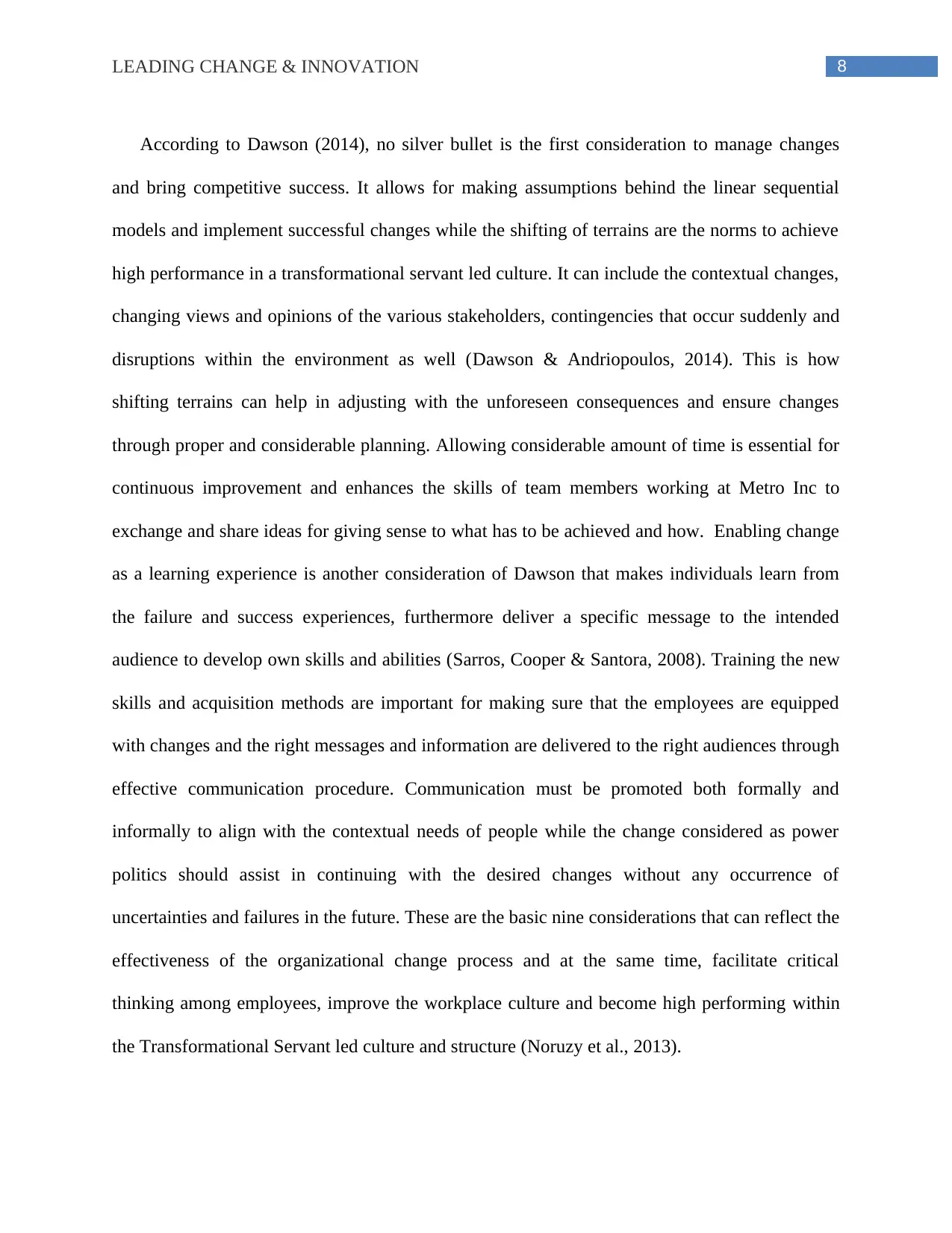
8LEADING CHANGE & INNOVATION
According to Dawson (2014), no silver bullet is the first consideration to manage changes
and bring competitive success. It allows for making assumptions behind the linear sequential
models and implement successful changes while the shifting of terrains are the norms to achieve
high performance in a transformational servant led culture. It can include the contextual changes,
changing views and opinions of the various stakeholders, contingencies that occur suddenly and
disruptions within the environment as well (Dawson & Andriopoulos, 2014). This is how
shifting terrains can help in adjusting with the unforeseen consequences and ensure changes
through proper and considerable planning. Allowing considerable amount of time is essential for
continuous improvement and enhances the skills of team members working at Metro Inc to
exchange and share ideas for giving sense to what has to be achieved and how. Enabling change
as a learning experience is another consideration of Dawson that makes individuals learn from
the failure and success experiences, furthermore deliver a specific message to the intended
audience to develop own skills and abilities (Sarros, Cooper & Santora, 2008). Training the new
skills and acquisition methods are important for making sure that the employees are equipped
with changes and the right messages and information are delivered to the right audiences through
effective communication procedure. Communication must be promoted both formally and
informally to align with the contextual needs of people while the change considered as power
politics should assist in continuing with the desired changes without any occurrence of
uncertainties and failures in the future. These are the basic nine considerations that can reflect the
effectiveness of the organizational change process and at the same time, facilitate critical
thinking among employees, improve the workplace culture and become high performing within
the Transformational Servant led culture and structure (Noruzy et al., 2013).
According to Dawson (2014), no silver bullet is the first consideration to manage changes
and bring competitive success. It allows for making assumptions behind the linear sequential
models and implement successful changes while the shifting of terrains are the norms to achieve
high performance in a transformational servant led culture. It can include the contextual changes,
changing views and opinions of the various stakeholders, contingencies that occur suddenly and
disruptions within the environment as well (Dawson & Andriopoulos, 2014). This is how
shifting terrains can help in adjusting with the unforeseen consequences and ensure changes
through proper and considerable planning. Allowing considerable amount of time is essential for
continuous improvement and enhances the skills of team members working at Metro Inc to
exchange and share ideas for giving sense to what has to be achieved and how. Enabling change
as a learning experience is another consideration of Dawson that makes individuals learn from
the failure and success experiences, furthermore deliver a specific message to the intended
audience to develop own skills and abilities (Sarros, Cooper & Santora, 2008). Training the new
skills and acquisition methods are important for making sure that the employees are equipped
with changes and the right messages and information are delivered to the right audiences through
effective communication procedure. Communication must be promoted both formally and
informally to align with the contextual needs of people while the change considered as power
politics should assist in continuing with the desired changes without any occurrence of
uncertainties and failures in the future. These are the basic nine considerations that can reflect the
effectiveness of the organizational change process and at the same time, facilitate critical
thinking among employees, improve the workplace culture and become high performing within
the Transformational Servant led culture and structure (Noruzy et al., 2013).
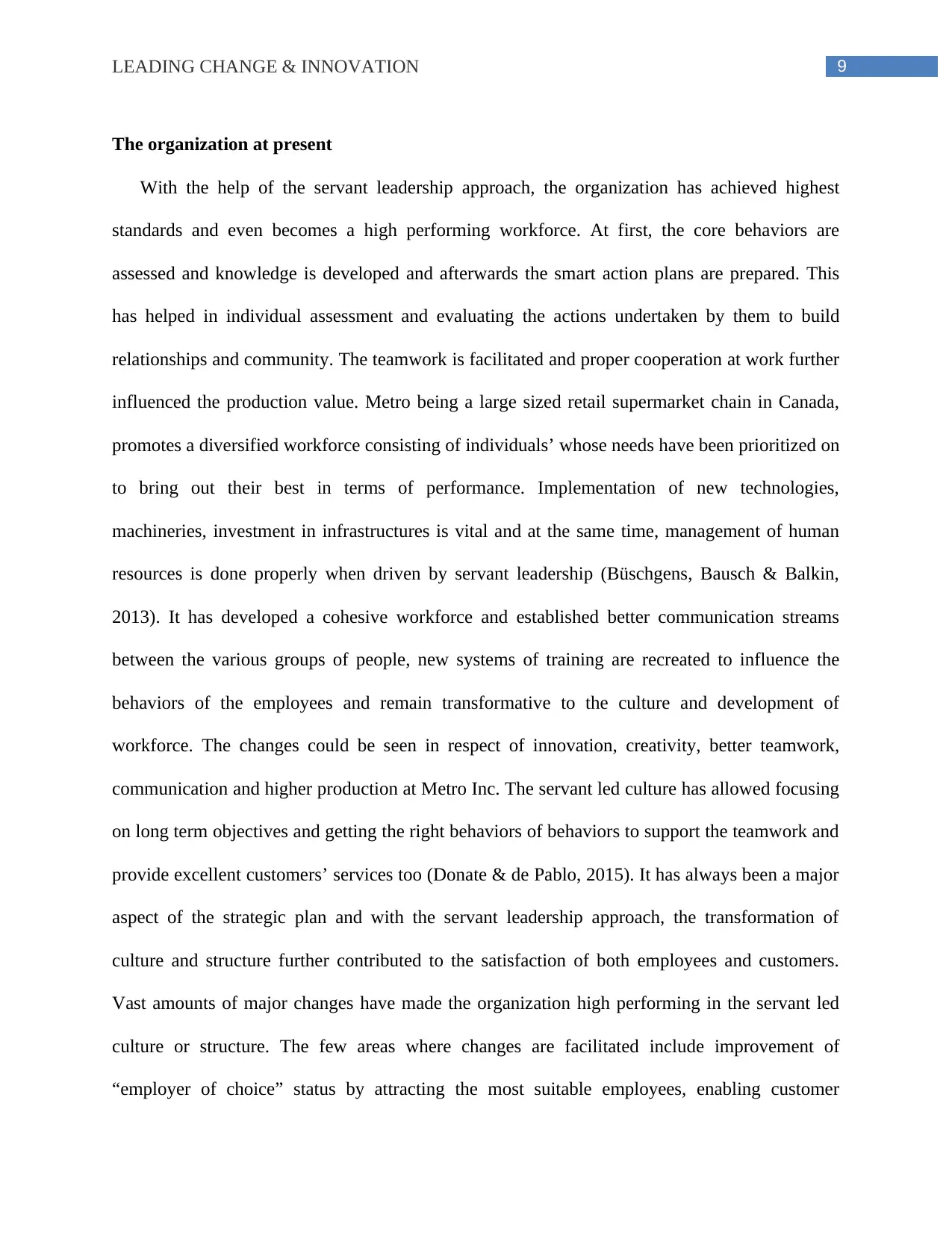
9LEADING CHANGE & INNOVATION
The organization at present
With the help of the servant leadership approach, the organization has achieved highest
standards and even becomes a high performing workforce. At first, the core behaviors are
assessed and knowledge is developed and afterwards the smart action plans are prepared. This
has helped in individual assessment and evaluating the actions undertaken by them to build
relationships and community. The teamwork is facilitated and proper cooperation at work further
influenced the production value. Metro being a large sized retail supermarket chain in Canada,
promotes a diversified workforce consisting of individuals’ whose needs have been prioritized on
to bring out their best in terms of performance. Implementation of new technologies,
machineries, investment in infrastructures is vital and at the same time, management of human
resources is done properly when driven by servant leadership (Büschgens, Bausch & Balkin,
2013). It has developed a cohesive workforce and established better communication streams
between the various groups of people, new systems of training are recreated to influence the
behaviors of the employees and remain transformative to the culture and development of
workforce. The changes could be seen in respect of innovation, creativity, better teamwork,
communication and higher production at Metro Inc. The servant led culture has allowed focusing
on long term objectives and getting the right behaviors of behaviors to support the teamwork and
provide excellent customers’ services too (Donate & de Pablo, 2015). It has always been a major
aspect of the strategic plan and with the servant leadership approach, the transformation of
culture and structure further contributed to the satisfaction of both employees and customers.
Vast amounts of major changes have made the organization high performing in the servant led
culture or structure. The few areas where changes are facilitated include improvement of
“employer of choice” status by attracting the most suitable employees, enabling customer
The organization at present
With the help of the servant leadership approach, the organization has achieved highest
standards and even becomes a high performing workforce. At first, the core behaviors are
assessed and knowledge is developed and afterwards the smart action plans are prepared. This
has helped in individual assessment and evaluating the actions undertaken by them to build
relationships and community. The teamwork is facilitated and proper cooperation at work further
influenced the production value. Metro being a large sized retail supermarket chain in Canada,
promotes a diversified workforce consisting of individuals’ whose needs have been prioritized on
to bring out their best in terms of performance. Implementation of new technologies,
machineries, investment in infrastructures is vital and at the same time, management of human
resources is done properly when driven by servant leadership (Büschgens, Bausch & Balkin,
2013). It has developed a cohesive workforce and established better communication streams
between the various groups of people, new systems of training are recreated to influence the
behaviors of the employees and remain transformative to the culture and development of
workforce. The changes could be seen in respect of innovation, creativity, better teamwork,
communication and higher production at Metro Inc. The servant led culture has allowed focusing
on long term objectives and getting the right behaviors of behaviors to support the teamwork and
provide excellent customers’ services too (Donate & de Pablo, 2015). It has always been a major
aspect of the strategic plan and with the servant leadership approach, the transformation of
culture and structure further contributed to the satisfaction of both employees and customers.
Vast amounts of major changes have made the organization high performing in the servant led
culture or structure. The few areas where changes are facilitated include improvement of
“employer of choice” status by attracting the most suitable employees, enabling customer
Secure Best Marks with AI Grader
Need help grading? Try our AI Grader for instant feedback on your assignments.
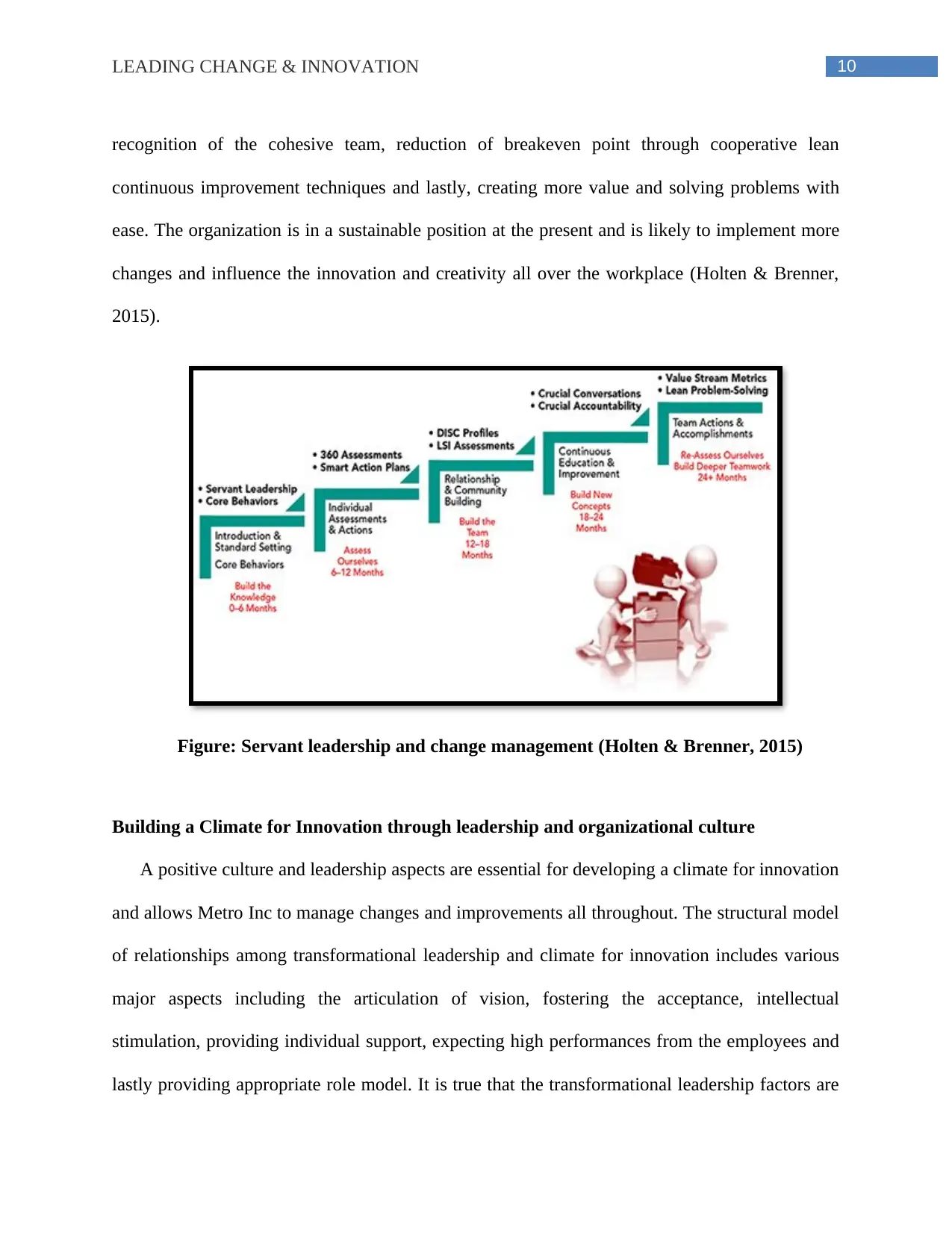
10LEADING CHANGE & INNOVATION
recognition of the cohesive team, reduction of breakeven point through cooperative lean
continuous improvement techniques and lastly, creating more value and solving problems with
ease. The organization is in a sustainable position at the present and is likely to implement more
changes and influence the innovation and creativity all over the workplace (Holten & Brenner,
2015).
Figure: Servant leadership and change management (Holten & Brenner, 2015)
Building a Climate for Innovation through leadership and organizational culture
A positive culture and leadership aspects are essential for developing a climate for innovation
and allows Metro Inc to manage changes and improvements all throughout. The structural model
of relationships among transformational leadership and climate for innovation includes various
major aspects including the articulation of vision, fostering the acceptance, intellectual
stimulation, providing individual support, expecting high performances from the employees and
lastly providing appropriate role model. It is true that the transformational leadership factors are
recognition of the cohesive team, reduction of breakeven point through cooperative lean
continuous improvement techniques and lastly, creating more value and solving problems with
ease. The organization is in a sustainable position at the present and is likely to implement more
changes and influence the innovation and creativity all over the workplace (Holten & Brenner,
2015).
Figure: Servant leadership and change management (Holten & Brenner, 2015)
Building a Climate for Innovation through leadership and organizational culture
A positive culture and leadership aspects are essential for developing a climate for innovation
and allows Metro Inc to manage changes and improvements all throughout. The structural model
of relationships among transformational leadership and climate for innovation includes various
major aspects including the articulation of vision, fostering the acceptance, intellectual
stimulation, providing individual support, expecting high performances from the employees and
lastly providing appropriate role model. It is true that the transformational leadership factors are
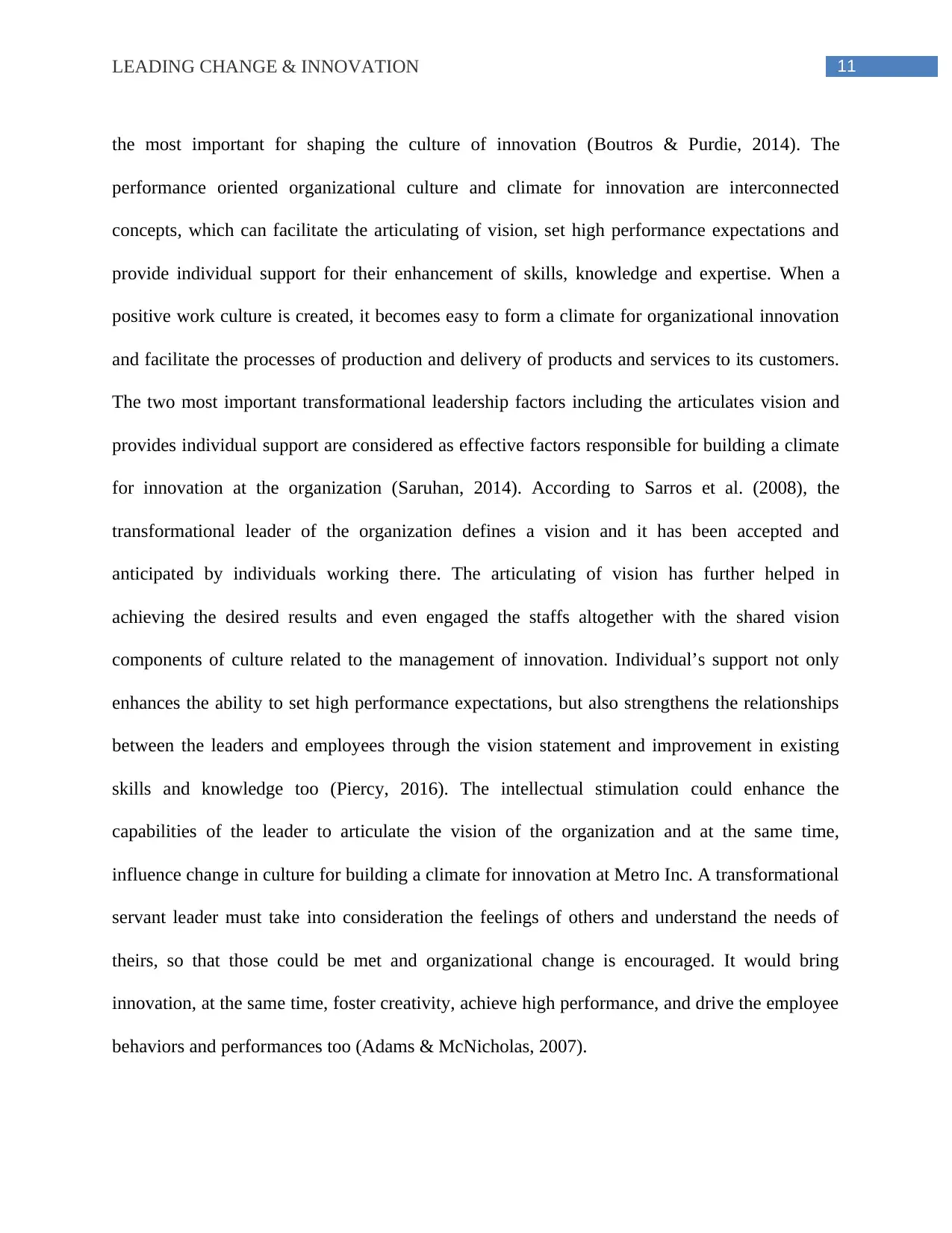
11LEADING CHANGE & INNOVATION
the most important for shaping the culture of innovation (Boutros & Purdie, 2014). The
performance oriented organizational culture and climate for innovation are interconnected
concepts, which can facilitate the articulating of vision, set high performance expectations and
provide individual support for their enhancement of skills, knowledge and expertise. When a
positive work culture is created, it becomes easy to form a climate for organizational innovation
and facilitate the processes of production and delivery of products and services to its customers.
The two most important transformational leadership factors including the articulates vision and
provides individual support are considered as effective factors responsible for building a climate
for innovation at the organization (Saruhan, 2014). According to Sarros et al. (2008), the
transformational leader of the organization defines a vision and it has been accepted and
anticipated by individuals working there. The articulating of vision has further helped in
achieving the desired results and even engaged the staffs altogether with the shared vision
components of culture related to the management of innovation. Individual’s support not only
enhances the ability to set high performance expectations, but also strengthens the relationships
between the leaders and employees through the vision statement and improvement in existing
skills and knowledge too (Piercy, 2016). The intellectual stimulation could enhance the
capabilities of the leader to articulate the vision of the organization and at the same time,
influence change in culture for building a climate for innovation at Metro Inc. A transformational
servant leader must take into consideration the feelings of others and understand the needs of
theirs, so that those could be met and organizational change is encouraged. It would bring
innovation, at the same time, foster creativity, achieve high performance, and drive the employee
behaviors and performances too (Adams & McNicholas, 2007).
the most important for shaping the culture of innovation (Boutros & Purdie, 2014). The
performance oriented organizational culture and climate for innovation are interconnected
concepts, which can facilitate the articulating of vision, set high performance expectations and
provide individual support for their enhancement of skills, knowledge and expertise. When a
positive work culture is created, it becomes easy to form a climate for organizational innovation
and facilitate the processes of production and delivery of products and services to its customers.
The two most important transformational leadership factors including the articulates vision and
provides individual support are considered as effective factors responsible for building a climate
for innovation at the organization (Saruhan, 2014). According to Sarros et al. (2008), the
transformational leader of the organization defines a vision and it has been accepted and
anticipated by individuals working there. The articulating of vision has further helped in
achieving the desired results and even engaged the staffs altogether with the shared vision
components of culture related to the management of innovation. Individual’s support not only
enhances the ability to set high performance expectations, but also strengthens the relationships
between the leaders and employees through the vision statement and improvement in existing
skills and knowledge too (Piercy, 2016). The intellectual stimulation could enhance the
capabilities of the leader to articulate the vision of the organization and at the same time,
influence change in culture for building a climate for innovation at Metro Inc. A transformational
servant leader must take into consideration the feelings of others and understand the needs of
theirs, so that those could be met and organizational change is encouraged. It would bring
innovation, at the same time, foster creativity, achieve high performance, and drive the employee
behaviors and performances too (Adams & McNicholas, 2007).
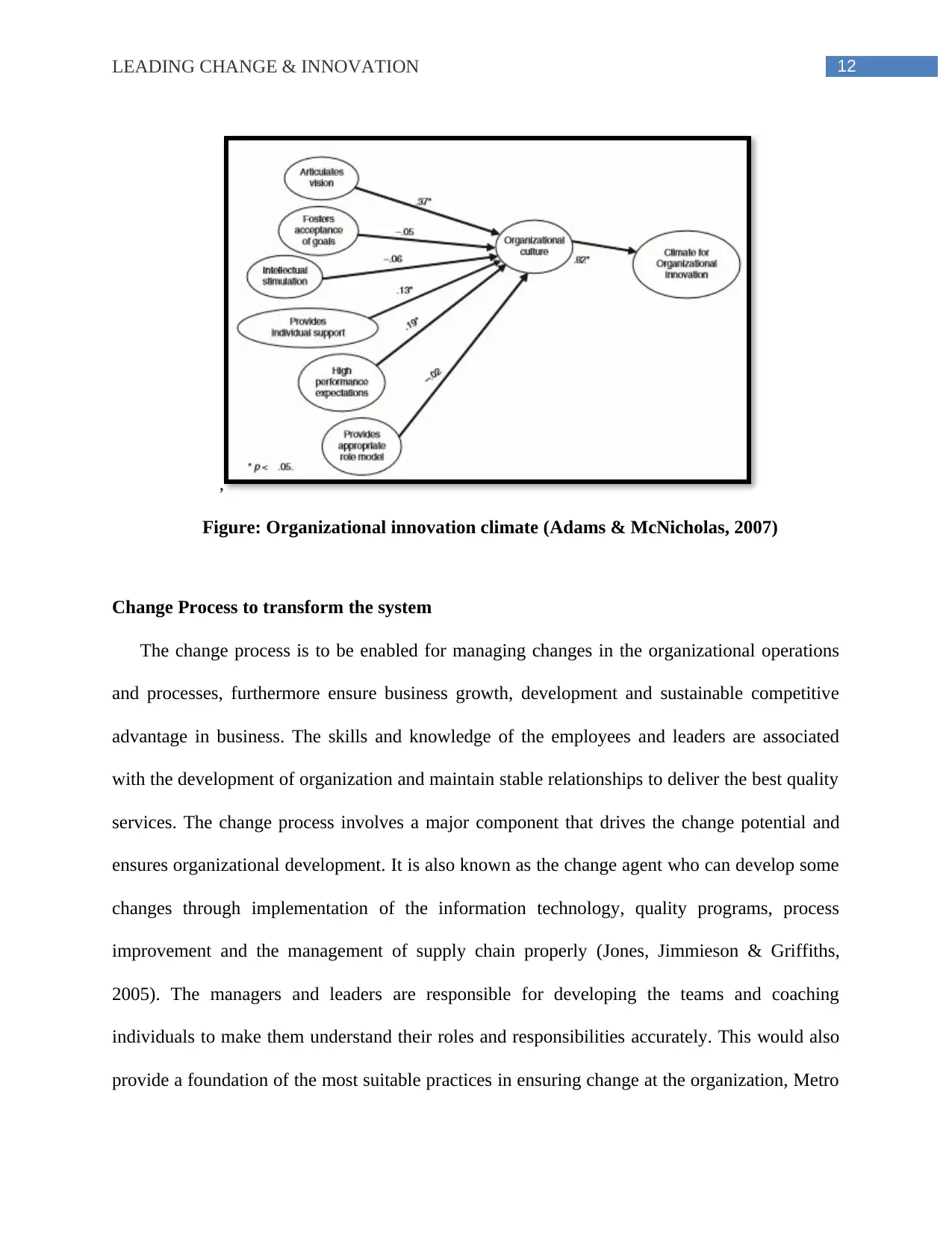
12LEADING CHANGE & INNOVATION
,
Figure: Organizational innovation climate (Adams & McNicholas, 2007)
Change Process to transform the system
The change process is to be enabled for managing changes in the organizational operations
and processes, furthermore ensure business growth, development and sustainable competitive
advantage in business. The skills and knowledge of the employees and leaders are associated
with the development of organization and maintain stable relationships to deliver the best quality
services. The change process involves a major component that drives the change potential and
ensures organizational development. It is also known as the change agent who can develop some
changes through implementation of the information technology, quality programs, process
improvement and the management of supply chain properly (Jones, Jimmieson & Griffiths,
2005). The managers and leaders are responsible for developing the teams and coaching
individuals to make them understand their roles and responsibilities accurately. This would also
provide a foundation of the most suitable practices in ensuring change at the organization, Metro
,
Figure: Organizational innovation climate (Adams & McNicholas, 2007)
Change Process to transform the system
The change process is to be enabled for managing changes in the organizational operations
and processes, furthermore ensure business growth, development and sustainable competitive
advantage in business. The skills and knowledge of the employees and leaders are associated
with the development of organization and maintain stable relationships to deliver the best quality
services. The change process involves a major component that drives the change potential and
ensures organizational development. It is also known as the change agent who can develop some
changes through implementation of the information technology, quality programs, process
improvement and the management of supply chain properly (Jones, Jimmieson & Griffiths,
2005). The managers and leaders are responsible for developing the teams and coaching
individuals to make them understand their roles and responsibilities accurately. This would also
provide a foundation of the most suitable practices in ensuring change at the organization, Metro
Paraphrase This Document
Need a fresh take? Get an instant paraphrase of this document with our AI Paraphraser
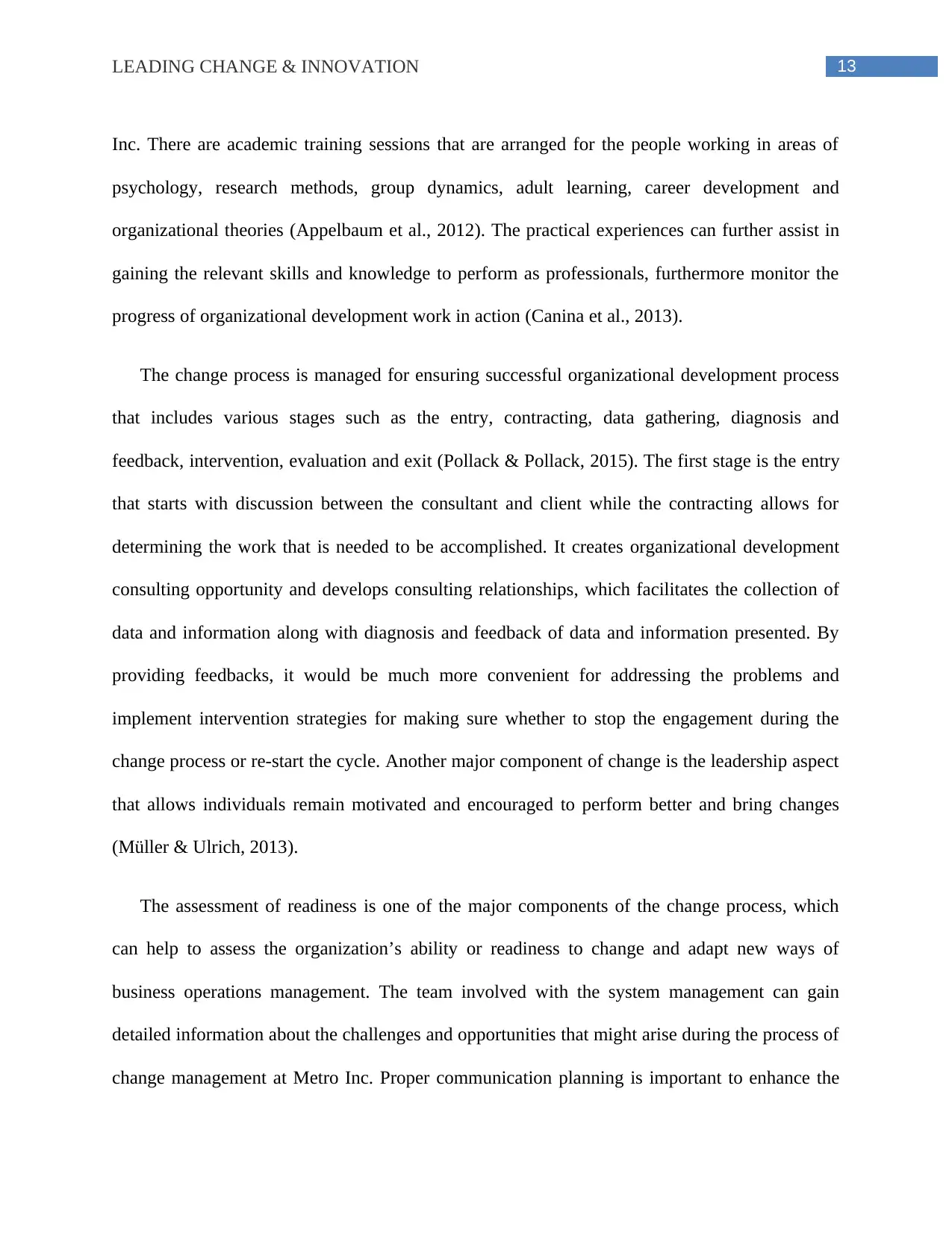
13LEADING CHANGE & INNOVATION
Inc. There are academic training sessions that are arranged for the people working in areas of
psychology, research methods, group dynamics, adult learning, career development and
organizational theories (Appelbaum et al., 2012). The practical experiences can further assist in
gaining the relevant skills and knowledge to perform as professionals, furthermore monitor the
progress of organizational development work in action (Canina et al., 2013).
The change process is managed for ensuring successful organizational development process
that includes various stages such as the entry, contracting, data gathering, diagnosis and
feedback, intervention, evaluation and exit (Pollack & Pollack, 2015). The first stage is the entry
that starts with discussion between the consultant and client while the contracting allows for
determining the work that is needed to be accomplished. It creates organizational development
consulting opportunity and develops consulting relationships, which facilitates the collection of
data and information along with diagnosis and feedback of data and information presented. By
providing feedbacks, it would be much more convenient for addressing the problems and
implement intervention strategies for making sure whether to stop the engagement during the
change process or re-start the cycle. Another major component of change is the leadership aspect
that allows individuals remain motivated and encouraged to perform better and bring changes
(Müller & Ulrich, 2013).
The assessment of readiness is one of the major components of the change process, which
can help to assess the organization’s ability or readiness to change and adapt new ways of
business operations management. The team involved with the system management can gain
detailed information about the challenges and opportunities that might arise during the process of
change management at Metro Inc. Proper communication planning is important to enhance the
Inc. There are academic training sessions that are arranged for the people working in areas of
psychology, research methods, group dynamics, adult learning, career development and
organizational theories (Appelbaum et al., 2012). The practical experiences can further assist in
gaining the relevant skills and knowledge to perform as professionals, furthermore monitor the
progress of organizational development work in action (Canina et al., 2013).
The change process is managed for ensuring successful organizational development process
that includes various stages such as the entry, contracting, data gathering, diagnosis and
feedback, intervention, evaluation and exit (Pollack & Pollack, 2015). The first stage is the entry
that starts with discussion between the consultant and client while the contracting allows for
determining the work that is needed to be accomplished. It creates organizational development
consulting opportunity and develops consulting relationships, which facilitates the collection of
data and information along with diagnosis and feedback of data and information presented. By
providing feedbacks, it would be much more convenient for addressing the problems and
implement intervention strategies for making sure whether to stop the engagement during the
change process or re-start the cycle. Another major component of change is the leadership aspect
that allows individuals remain motivated and encouraged to perform better and bring changes
(Müller & Ulrich, 2013).
The assessment of readiness is one of the major components of the change process, which
can help to assess the organization’s ability or readiness to change and adapt new ways of
business operations management. The team involved with the system management can gain
detailed information about the challenges and opportunities that might arise during the process of
change management at Metro Inc. Proper communication planning is important to enhance the
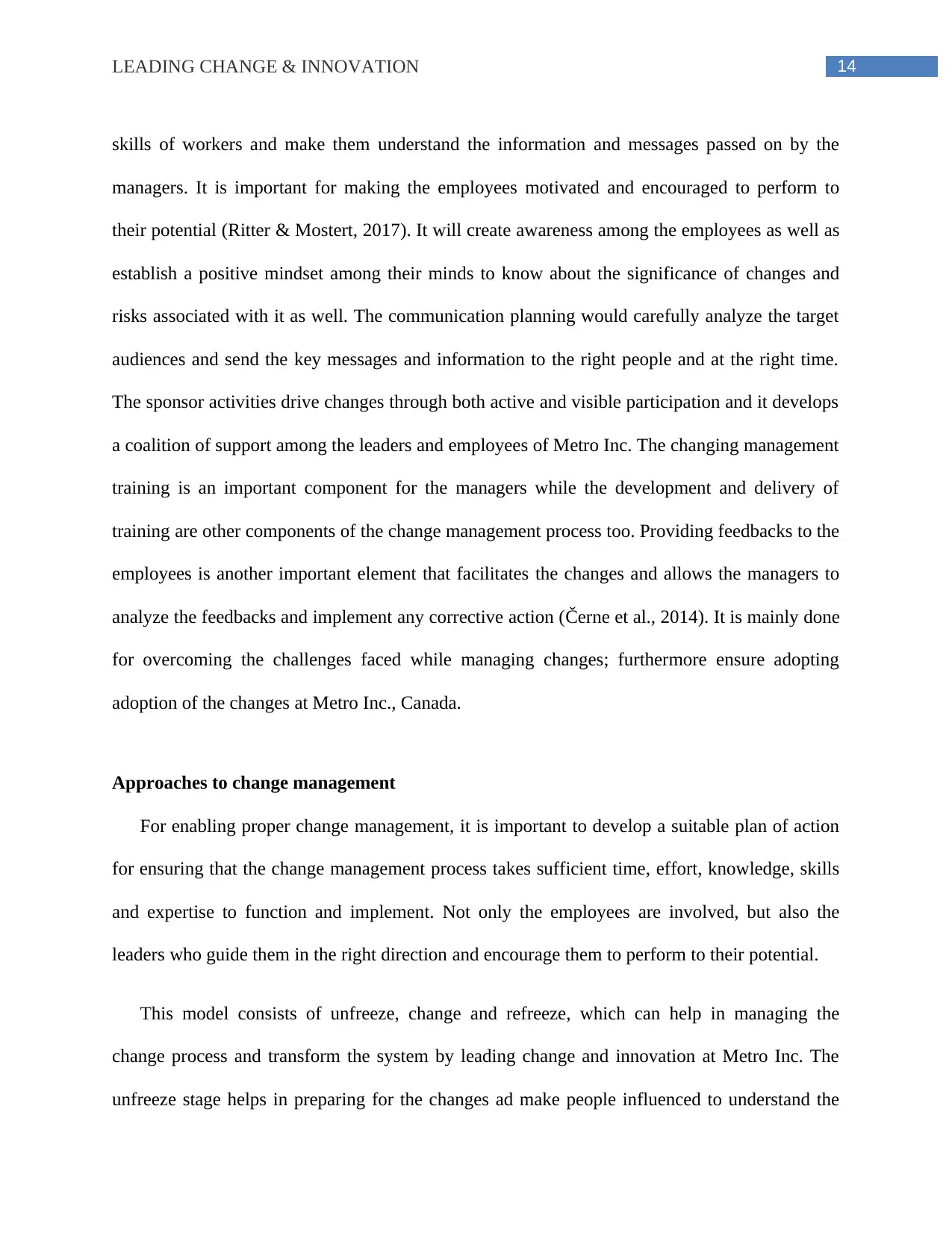
14LEADING CHANGE & INNOVATION
skills of workers and make them understand the information and messages passed on by the
managers. It is important for making the employees motivated and encouraged to perform to
their potential (Ritter & Mostert, 2017). It will create awareness among the employees as well as
establish a positive mindset among their minds to know about the significance of changes and
risks associated with it as well. The communication planning would carefully analyze the target
audiences and send the key messages and information to the right people and at the right time.
The sponsor activities drive changes through both active and visible participation and it develops
a coalition of support among the leaders and employees of Metro Inc. The changing management
training is an important component for the managers while the development and delivery of
training are other components of the change management process too. Providing feedbacks to the
employees is another important element that facilitates the changes and allows the managers to
analyze the feedbacks and implement any corrective action (Černe et al., 2014). It is mainly done
for overcoming the challenges faced while managing changes; furthermore ensure adopting
adoption of the changes at Metro Inc., Canada.
Approaches to change management
For enabling proper change management, it is important to develop a suitable plan of action
for ensuring that the change management process takes sufficient time, effort, knowledge, skills
and expertise to function and implement. Not only the employees are involved, but also the
leaders who guide them in the right direction and encourage them to perform to their potential.
This model consists of unfreeze, change and refreeze, which can help in managing the
change process and transform the system by leading change and innovation at Metro Inc. The
unfreeze stage helps in preparing for the changes ad make people influenced to understand the
skills of workers and make them understand the information and messages passed on by the
managers. It is important for making the employees motivated and encouraged to perform to
their potential (Ritter & Mostert, 2017). It will create awareness among the employees as well as
establish a positive mindset among their minds to know about the significance of changes and
risks associated with it as well. The communication planning would carefully analyze the target
audiences and send the key messages and information to the right people and at the right time.
The sponsor activities drive changes through both active and visible participation and it develops
a coalition of support among the leaders and employees of Metro Inc. The changing management
training is an important component for the managers while the development and delivery of
training are other components of the change management process too. Providing feedbacks to the
employees is another important element that facilitates the changes and allows the managers to
analyze the feedbacks and implement any corrective action (Černe et al., 2014). It is mainly done
for overcoming the challenges faced while managing changes; furthermore ensure adopting
adoption of the changes at Metro Inc., Canada.
Approaches to change management
For enabling proper change management, it is important to develop a suitable plan of action
for ensuring that the change management process takes sufficient time, effort, knowledge, skills
and expertise to function and implement. Not only the employees are involved, but also the
leaders who guide them in the right direction and encourage them to perform to their potential.
This model consists of unfreeze, change and refreeze, which can help in managing the
change process and transform the system by leading change and innovation at Metro Inc. The
unfreeze stage helps in preparing for the changes ad make people influenced to understand the
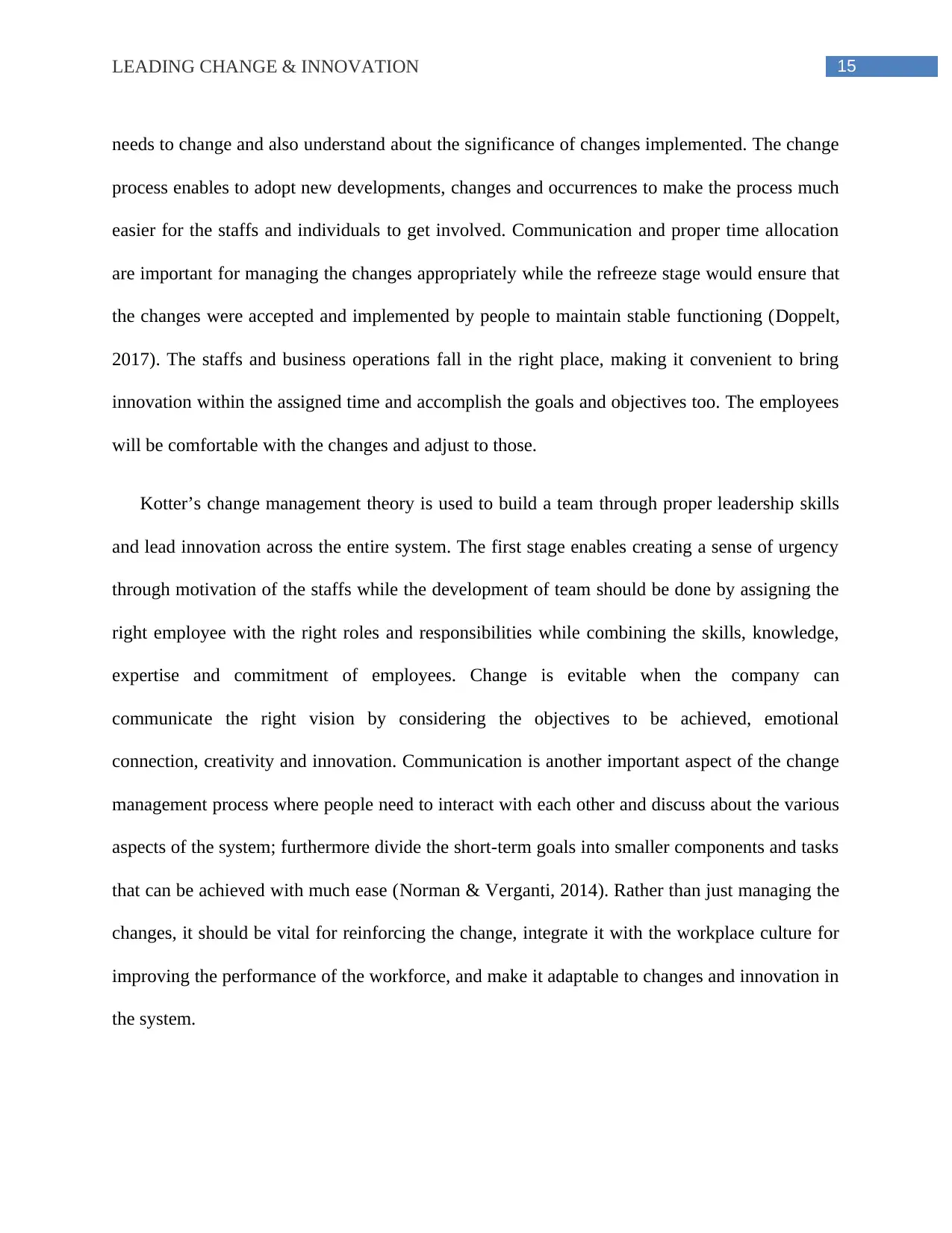
15LEADING CHANGE & INNOVATION
needs to change and also understand about the significance of changes implemented. The change
process enables to adopt new developments, changes and occurrences to make the process much
easier for the staffs and individuals to get involved. Communication and proper time allocation
are important for managing the changes appropriately while the refreeze stage would ensure that
the changes were accepted and implemented by people to maintain stable functioning (Doppelt,
2017). The staffs and business operations fall in the right place, making it convenient to bring
innovation within the assigned time and accomplish the goals and objectives too. The employees
will be comfortable with the changes and adjust to those.
Kotter’s change management theory is used to build a team through proper leadership skills
and lead innovation across the entire system. The first stage enables creating a sense of urgency
through motivation of the staffs while the development of team should be done by assigning the
right employee with the right roles and responsibilities while combining the skills, knowledge,
expertise and commitment of employees. Change is evitable when the company can
communicate the right vision by considering the objectives to be achieved, emotional
connection, creativity and innovation. Communication is another important aspect of the change
management process where people need to interact with each other and discuss about the various
aspects of the system; furthermore divide the short-term goals into smaller components and tasks
that can be achieved with much ease (Norman & Verganti, 2014). Rather than just managing the
changes, it should be vital for reinforcing the change, integrate it with the workplace culture for
improving the performance of the workforce, and make it adaptable to changes and innovation in
the system.
needs to change and also understand about the significance of changes implemented. The change
process enables to adopt new developments, changes and occurrences to make the process much
easier for the staffs and individuals to get involved. Communication and proper time allocation
are important for managing the changes appropriately while the refreeze stage would ensure that
the changes were accepted and implemented by people to maintain stable functioning (Doppelt,
2017). The staffs and business operations fall in the right place, making it convenient to bring
innovation within the assigned time and accomplish the goals and objectives too. The employees
will be comfortable with the changes and adjust to those.
Kotter’s change management theory is used to build a team through proper leadership skills
and lead innovation across the entire system. The first stage enables creating a sense of urgency
through motivation of the staffs while the development of team should be done by assigning the
right employee with the right roles and responsibilities while combining the skills, knowledge,
expertise and commitment of employees. Change is evitable when the company can
communicate the right vision by considering the objectives to be achieved, emotional
connection, creativity and innovation. Communication is another important aspect of the change
management process where people need to interact with each other and discuss about the various
aspects of the system; furthermore divide the short-term goals into smaller components and tasks
that can be achieved with much ease (Norman & Verganti, 2014). Rather than just managing the
changes, it should be vital for reinforcing the change, integrate it with the workplace culture for
improving the performance of the workforce, and make it adaptable to changes and innovation in
the system.
Secure Best Marks with AI Grader
Need help grading? Try our AI Grader for instant feedback on your assignments.
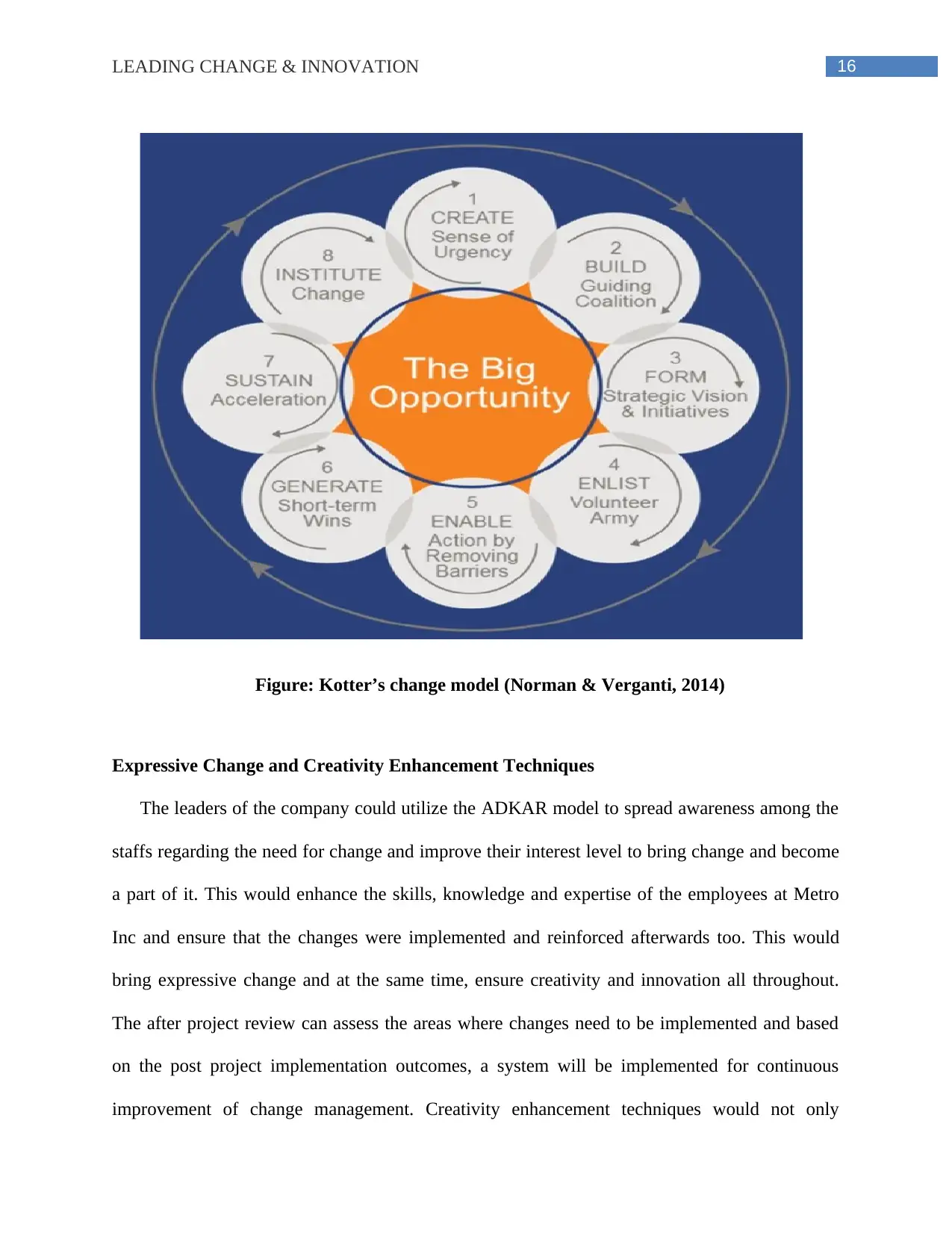
16LEADING CHANGE & INNOVATION
Figure: Kotter’s change model (Norman & Verganti, 2014)
Expressive Change and Creativity Enhancement Techniques
The leaders of the company could utilize the ADKAR model to spread awareness among the
staffs regarding the need for change and improve their interest level to bring change and become
a part of it. This would enhance the skills, knowledge and expertise of the employees at Metro
Inc and ensure that the changes were implemented and reinforced afterwards too. This would
bring expressive change and at the same time, ensure creativity and innovation all throughout.
The after project review can assess the areas where changes need to be implemented and based
on the post project implementation outcomes, a system will be implemented for continuous
improvement of change management. Creativity enhancement techniques would not only
Figure: Kotter’s change model (Norman & Verganti, 2014)
Expressive Change and Creativity Enhancement Techniques
The leaders of the company could utilize the ADKAR model to spread awareness among the
staffs regarding the need for change and improve their interest level to bring change and become
a part of it. This would enhance the skills, knowledge and expertise of the employees at Metro
Inc and ensure that the changes were implemented and reinforced afterwards too. This would
bring expressive change and at the same time, ensure creativity and innovation all throughout.
The after project review can assess the areas where changes need to be implemented and based
on the post project implementation outcomes, a system will be implemented for continuous
improvement of change management. Creativity enhancement techniques would not only
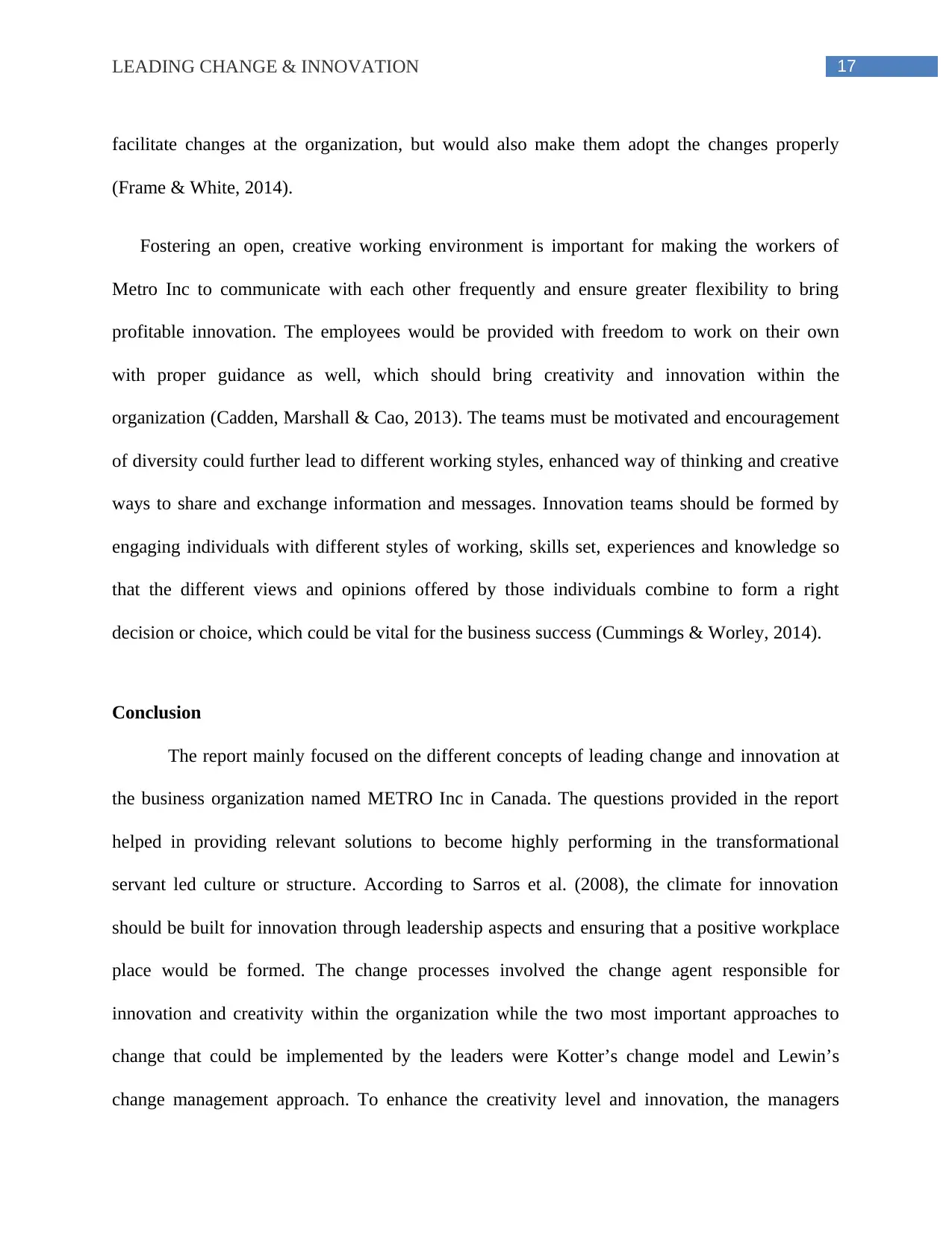
17LEADING CHANGE & INNOVATION
facilitate changes at the organization, but would also make them adopt the changes properly
(Frame & White, 2014).
Fostering an open, creative working environment is important for making the workers of
Metro Inc to communicate with each other frequently and ensure greater flexibility to bring
profitable innovation. The employees would be provided with freedom to work on their own
with proper guidance as well, which should bring creativity and innovation within the
organization (Cadden, Marshall & Cao, 2013). The teams must be motivated and encouragement
of diversity could further lead to different working styles, enhanced way of thinking and creative
ways to share and exchange information and messages. Innovation teams should be formed by
engaging individuals with different styles of working, skills set, experiences and knowledge so
that the different views and opinions offered by those individuals combine to form a right
decision or choice, which could be vital for the business success (Cummings & Worley, 2014).
Conclusion
The report mainly focused on the different concepts of leading change and innovation at
the business organization named METRO Inc in Canada. The questions provided in the report
helped in providing relevant solutions to become highly performing in the transformational
servant led culture or structure. According to Sarros et al. (2008), the climate for innovation
should be built for innovation through leadership aspects and ensuring that a positive workplace
place would be formed. The change processes involved the change agent responsible for
innovation and creativity within the organization while the two most important approaches to
change that could be implemented by the leaders were Kotter’s change model and Lewin’s
change management approach. To enhance the creativity level and innovation, the managers
facilitate changes at the organization, but would also make them adopt the changes properly
(Frame & White, 2014).
Fostering an open, creative working environment is important for making the workers of
Metro Inc to communicate with each other frequently and ensure greater flexibility to bring
profitable innovation. The employees would be provided with freedom to work on their own
with proper guidance as well, which should bring creativity and innovation within the
organization (Cadden, Marshall & Cao, 2013). The teams must be motivated and encouragement
of diversity could further lead to different working styles, enhanced way of thinking and creative
ways to share and exchange information and messages. Innovation teams should be formed by
engaging individuals with different styles of working, skills set, experiences and knowledge so
that the different views and opinions offered by those individuals combine to form a right
decision or choice, which could be vital for the business success (Cummings & Worley, 2014).
Conclusion
The report mainly focused on the different concepts of leading change and innovation at
the business organization named METRO Inc in Canada. The questions provided in the report
helped in providing relevant solutions to become highly performing in the transformational
servant led culture or structure. According to Sarros et al. (2008), the climate for innovation
should be built for innovation through leadership aspects and ensuring that a positive workplace
place would be formed. The change processes involved the change agent responsible for
innovation and creativity within the organization while the two most important approaches to
change that could be implemented by the leaders were Kotter’s change model and Lewin’s
change management approach. To enhance the creativity level and innovation, the managers
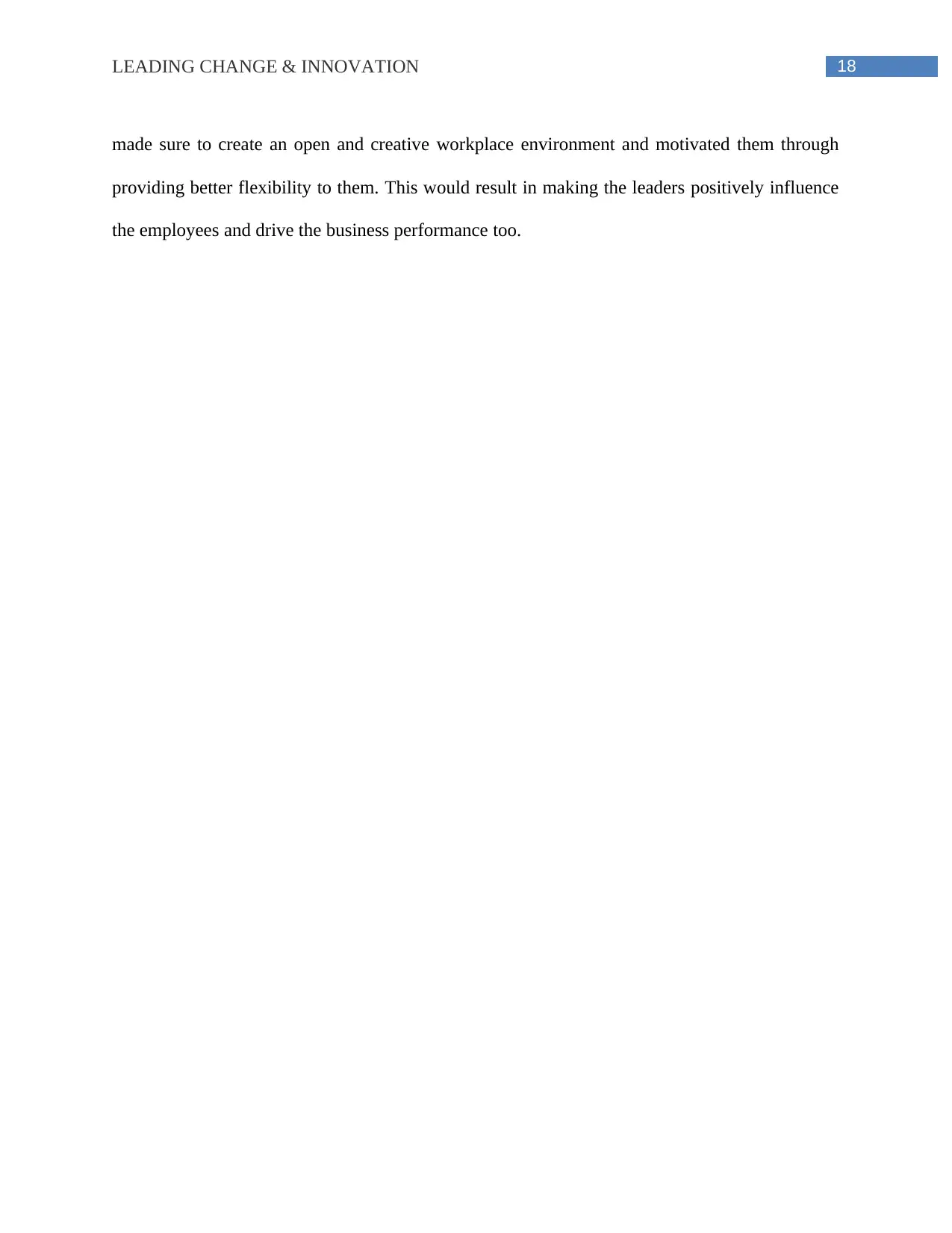
18LEADING CHANGE & INNOVATION
made sure to create an open and creative workplace environment and motivated them through
providing better flexibility to them. This would result in making the leaders positively influence
the employees and drive the business performance too.
made sure to create an open and creative workplace environment and motivated them through
providing better flexibility to them. This would result in making the leaders positively influence
the employees and drive the business performance too.
Paraphrase This Document
Need a fresh take? Get an instant paraphrase of this document with our AI Paraphraser
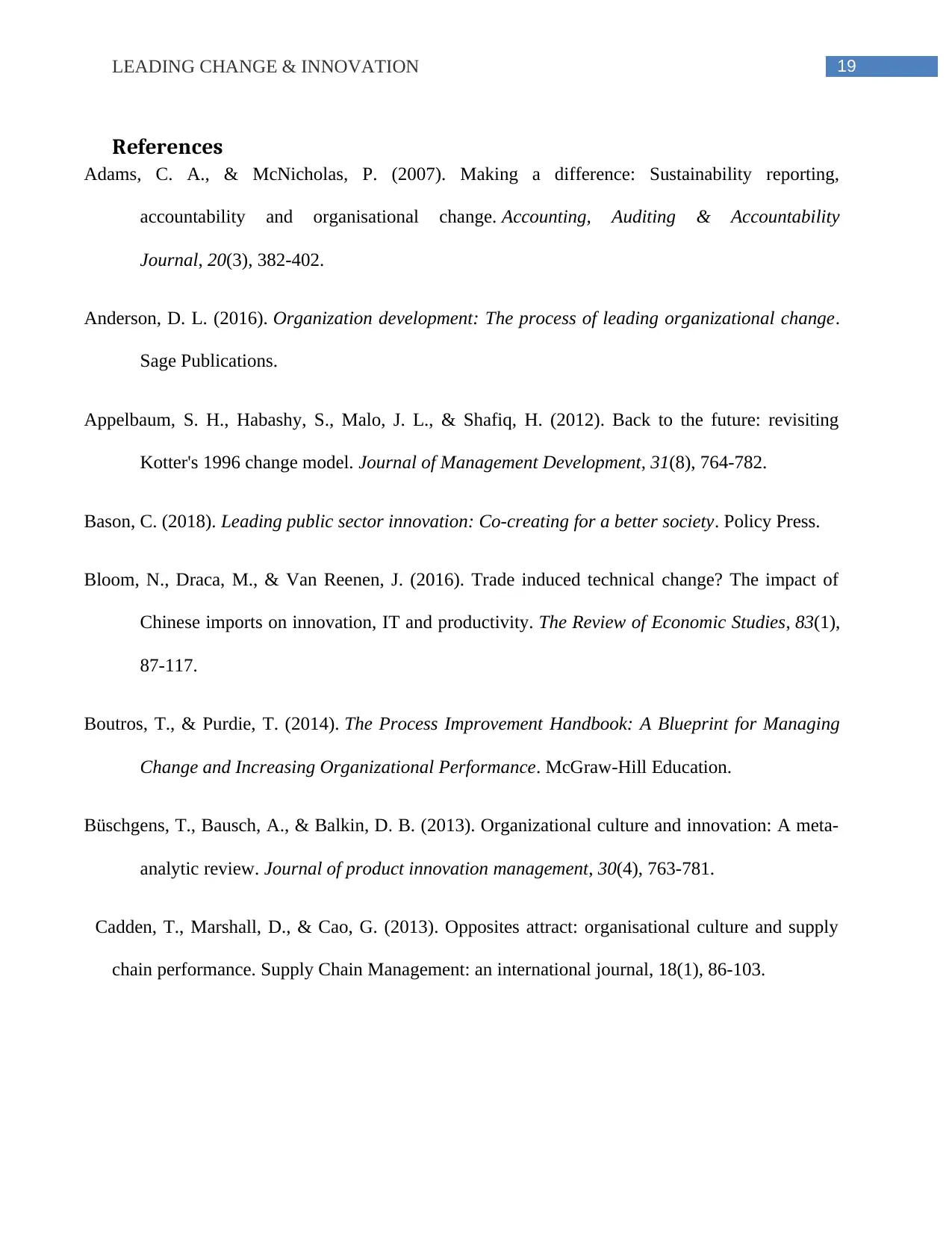
19LEADING CHANGE & INNOVATION
References
Adams, C. A., & McNicholas, P. (2007). Making a difference: Sustainability reporting,
accountability and organisational change. Accounting, Auditing & Accountability
Journal, 20(3), 382-402.
Anderson, D. L. (2016). Organization development: The process of leading organizational change.
Sage Publications.
Appelbaum, S. H., Habashy, S., Malo, J. L., & Shafiq, H. (2012). Back to the future: revisiting
Kotter's 1996 change model. Journal of Management Development, 31(8), 764-782.
Bason, C. (2018). Leading public sector innovation: Co-creating for a better society. Policy Press.
Bloom, N., Draca, M., & Van Reenen, J. (2016). Trade induced technical change? The impact of
Chinese imports on innovation, IT and productivity. The Review of Economic Studies, 83(1),
87-117.
Boutros, T., & Purdie, T. (2014). The Process Improvement Handbook: A Blueprint for Managing
Change and Increasing Organizational Performance. McGraw-Hill Education.
Büschgens, T., Bausch, A., & Balkin, D. B. (2013). Organizational culture and innovation: A meta‐
analytic review. Journal of product innovation management, 30(4), 763-781.
Cadden, T., Marshall, D., & Cao, G. (2013). Opposites attract: organisational culture and supply
chain performance. Supply Chain Management: an international journal, 18(1), 86-103.
References
Adams, C. A., & McNicholas, P. (2007). Making a difference: Sustainability reporting,
accountability and organisational change. Accounting, Auditing & Accountability
Journal, 20(3), 382-402.
Anderson, D. L. (2016). Organization development: The process of leading organizational change.
Sage Publications.
Appelbaum, S. H., Habashy, S., Malo, J. L., & Shafiq, H. (2012). Back to the future: revisiting
Kotter's 1996 change model. Journal of Management Development, 31(8), 764-782.
Bason, C. (2018). Leading public sector innovation: Co-creating for a better society. Policy Press.
Bloom, N., Draca, M., & Van Reenen, J. (2016). Trade induced technical change? The impact of
Chinese imports on innovation, IT and productivity. The Review of Economic Studies, 83(1),
87-117.
Boutros, T., & Purdie, T. (2014). The Process Improvement Handbook: A Blueprint for Managing
Change and Increasing Organizational Performance. McGraw-Hill Education.
Büschgens, T., Bausch, A., & Balkin, D. B. (2013). Organizational culture and innovation: A meta‐
analytic review. Journal of product innovation management, 30(4), 763-781.
Cadden, T., Marshall, D., & Cao, G. (2013). Opposites attract: organisational culture and supply
chain performance. Supply Chain Management: an international journal, 18(1), 86-103.
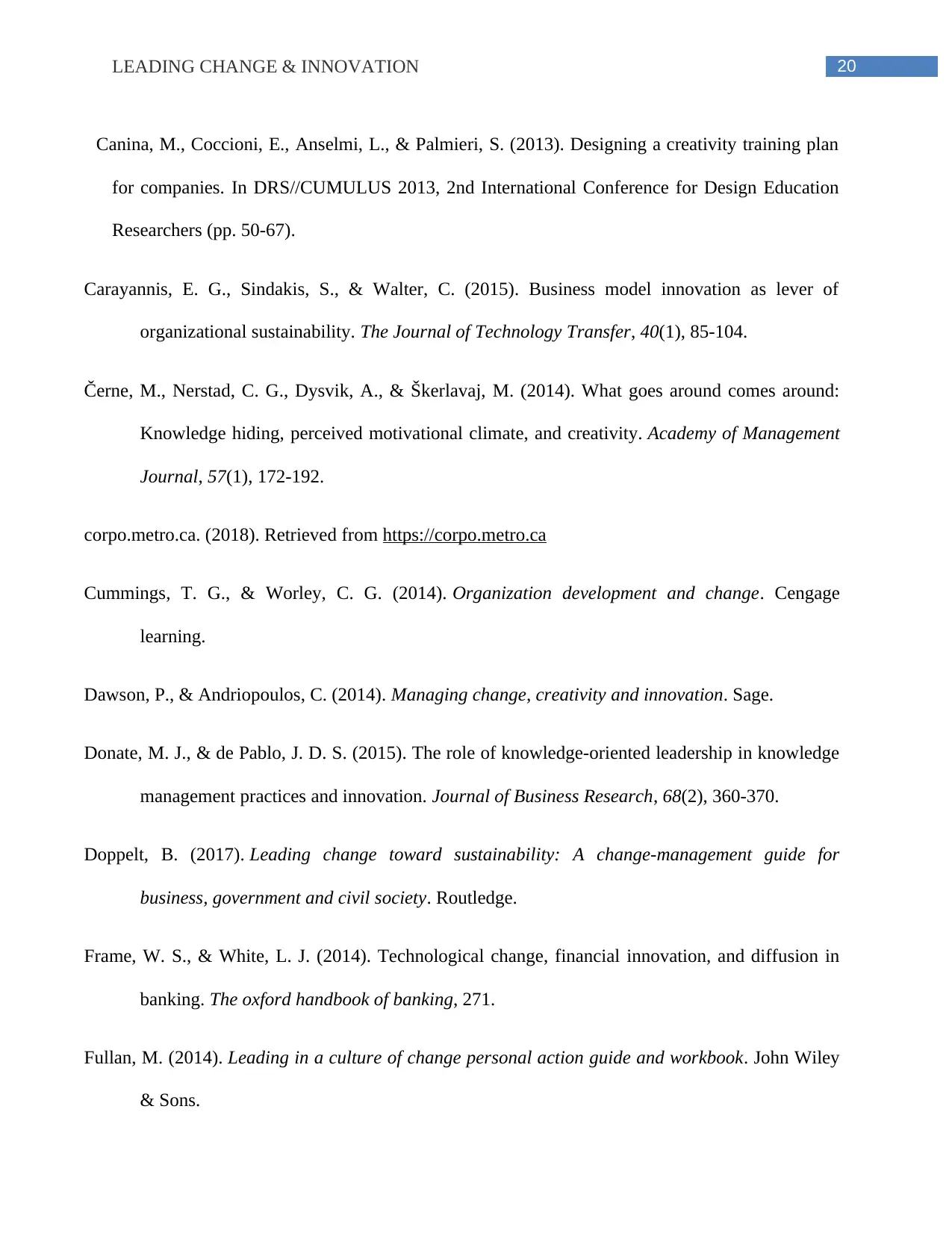
20LEADING CHANGE & INNOVATION
Canina, M., Coccioni, E., Anselmi, L., & Palmieri, S. (2013). Designing a creativity training plan
for companies. In DRS//CUMULUS 2013, 2nd International Conference for Design Education
Researchers (pp. 50-67).
Carayannis, E. G., Sindakis, S., & Walter, C. (2015). Business model innovation as lever of
organizational sustainability. The Journal of Technology Transfer, 40(1), 85-104.
Černe, M., Nerstad, C. G., Dysvik, A., & Škerlavaj, M. (2014). What goes around comes around:
Knowledge hiding, perceived motivational climate, and creativity. Academy of Management
Journal, 57(1), 172-192.
corpo.metro.ca. (2018). Retrieved from https://corpo.metro.ca
Cummings, T. G., & Worley, C. G. (2014). Organization development and change. Cengage
learning.
Dawson, P., & Andriopoulos, C. (2014). Managing change, creativity and innovation. Sage.
Donate, M. J., & de Pablo, J. D. S. (2015). The role of knowledge-oriented leadership in knowledge
management practices and innovation. Journal of Business Research, 68(2), 360-370.
Doppelt, B. (2017). Leading change toward sustainability: A change-management guide for
business, government and civil society. Routledge.
Frame, W. S., & White, L. J. (2014). Technological change, financial innovation, and diffusion in
banking. The oxford handbook of banking, 271.
Fullan, M. (2014). Leading in a culture of change personal action guide and workbook. John Wiley
& Sons.
Canina, M., Coccioni, E., Anselmi, L., & Palmieri, S. (2013). Designing a creativity training plan
for companies. In DRS//CUMULUS 2013, 2nd International Conference for Design Education
Researchers (pp. 50-67).
Carayannis, E. G., Sindakis, S., & Walter, C. (2015). Business model innovation as lever of
organizational sustainability. The Journal of Technology Transfer, 40(1), 85-104.
Černe, M., Nerstad, C. G., Dysvik, A., & Škerlavaj, M. (2014). What goes around comes around:
Knowledge hiding, perceived motivational climate, and creativity. Academy of Management
Journal, 57(1), 172-192.
corpo.metro.ca. (2018). Retrieved from https://corpo.metro.ca
Cummings, T. G., & Worley, C. G. (2014). Organization development and change. Cengage
learning.
Dawson, P., & Andriopoulos, C. (2014). Managing change, creativity and innovation. Sage.
Donate, M. J., & de Pablo, J. D. S. (2015). The role of knowledge-oriented leadership in knowledge
management practices and innovation. Journal of Business Research, 68(2), 360-370.
Doppelt, B. (2017). Leading change toward sustainability: A change-management guide for
business, government and civil society. Routledge.
Frame, W. S., & White, L. J. (2014). Technological change, financial innovation, and diffusion in
banking. The oxford handbook of banking, 271.
Fullan, M. (2014). Leading in a culture of change personal action guide and workbook. John Wiley
& Sons.
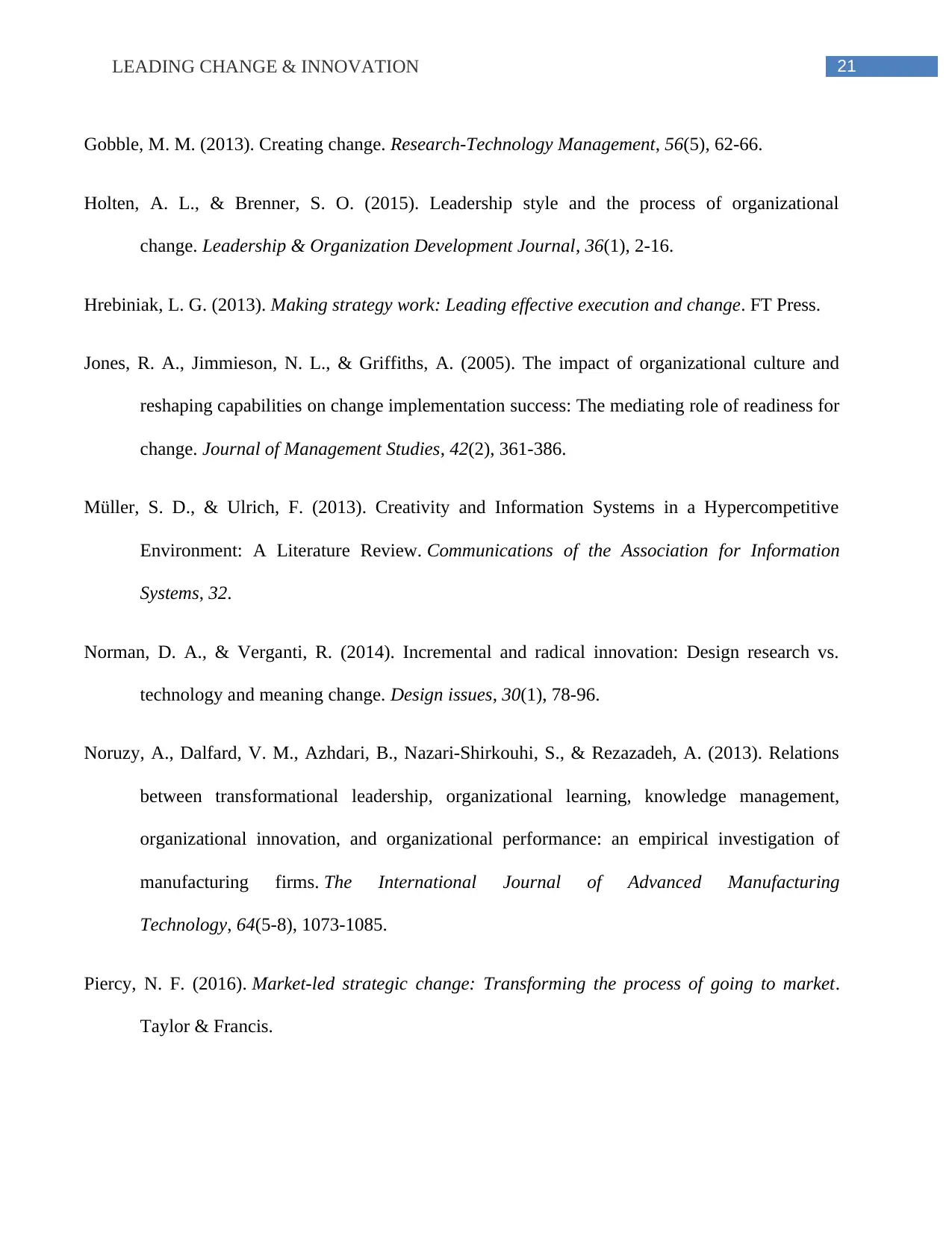
21LEADING CHANGE & INNOVATION
Gobble, M. M. (2013). Creating change. Research-Technology Management, 56(5), 62-66.
Holten, A. L., & Brenner, S. O. (2015). Leadership style and the process of organizational
change. Leadership & Organization Development Journal, 36(1), 2-16.
Hrebiniak, L. G. (2013). Making strategy work: Leading effective execution and change. FT Press.
Jones, R. A., Jimmieson, N. L., & Griffiths, A. (2005). The impact of organizational culture and
reshaping capabilities on change implementation success: The mediating role of readiness for
change. Journal of Management Studies, 42(2), 361-386.
Müller, S. D., & Ulrich, F. (2013). Creativity and Information Systems in a Hypercompetitive
Environment: A Literature Review. Communications of the Association for Information
Systems, 32.
Norman, D. A., & Verganti, R. (2014). Incremental and radical innovation: Design research vs.
technology and meaning change. Design issues, 30(1), 78-96.
Noruzy, A., Dalfard, V. M., Azhdari, B., Nazari-Shirkouhi, S., & Rezazadeh, A. (2013). Relations
between transformational leadership, organizational learning, knowledge management,
organizational innovation, and organizational performance: an empirical investigation of
manufacturing firms. The International Journal of Advanced Manufacturing
Technology, 64(5-8), 1073-1085.
Piercy, N. F. (2016). Market-led strategic change: Transforming the process of going to market.
Taylor & Francis.
Gobble, M. M. (2013). Creating change. Research-Technology Management, 56(5), 62-66.
Holten, A. L., & Brenner, S. O. (2015). Leadership style and the process of organizational
change. Leadership & Organization Development Journal, 36(1), 2-16.
Hrebiniak, L. G. (2013). Making strategy work: Leading effective execution and change. FT Press.
Jones, R. A., Jimmieson, N. L., & Griffiths, A. (2005). The impact of organizational culture and
reshaping capabilities on change implementation success: The mediating role of readiness for
change. Journal of Management Studies, 42(2), 361-386.
Müller, S. D., & Ulrich, F. (2013). Creativity and Information Systems in a Hypercompetitive
Environment: A Literature Review. Communications of the Association for Information
Systems, 32.
Norman, D. A., & Verganti, R. (2014). Incremental and radical innovation: Design research vs.
technology and meaning change. Design issues, 30(1), 78-96.
Noruzy, A., Dalfard, V. M., Azhdari, B., Nazari-Shirkouhi, S., & Rezazadeh, A. (2013). Relations
between transformational leadership, organizational learning, knowledge management,
organizational innovation, and organizational performance: an empirical investigation of
manufacturing firms. The International Journal of Advanced Manufacturing
Technology, 64(5-8), 1073-1085.
Piercy, N. F. (2016). Market-led strategic change: Transforming the process of going to market.
Taylor & Francis.
Secure Best Marks with AI Grader
Need help grading? Try our AI Grader for instant feedback on your assignments.
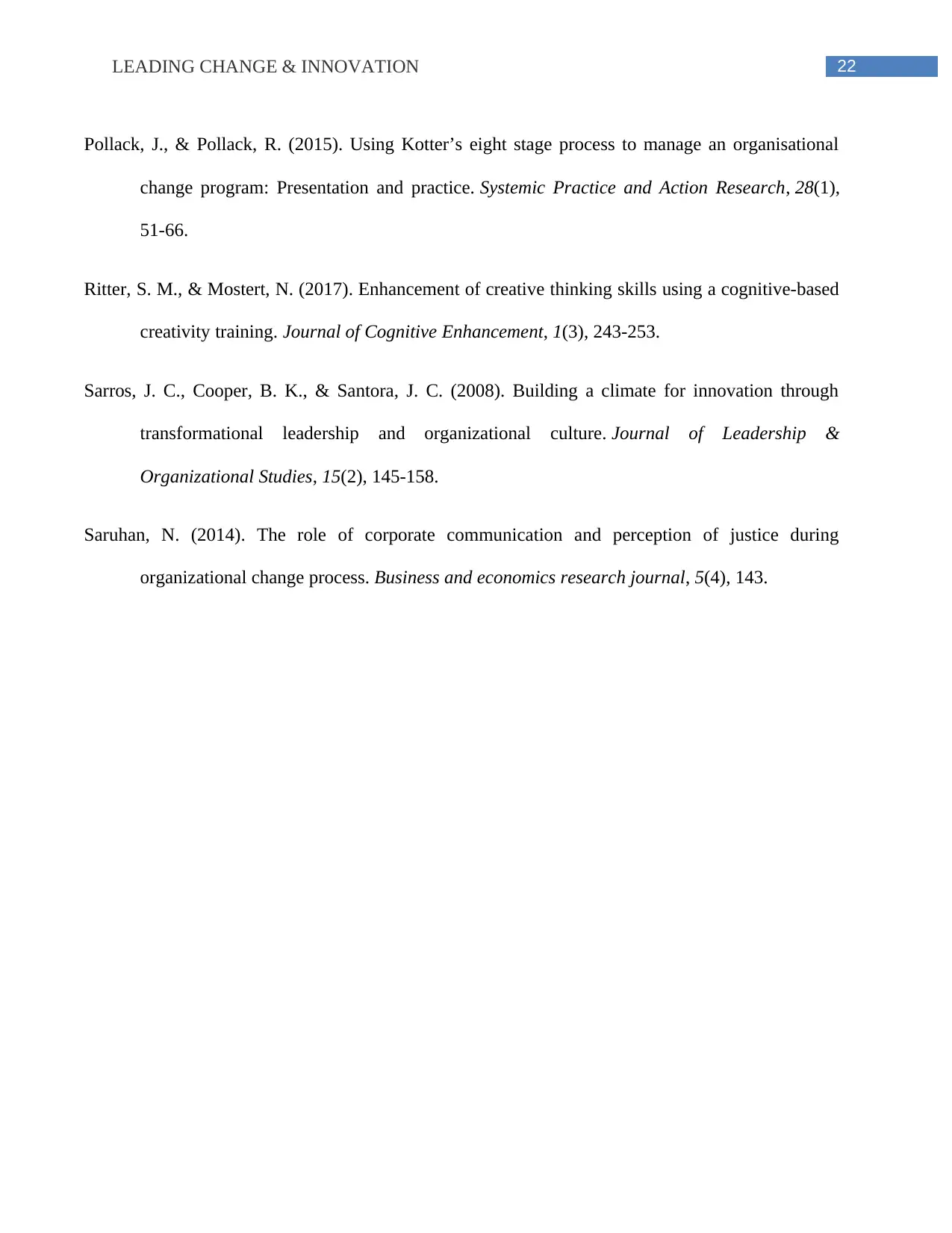
22LEADING CHANGE & INNOVATION
Pollack, J., & Pollack, R. (2015). Using Kotter’s eight stage process to manage an organisational
change program: Presentation and practice. Systemic Practice and Action Research, 28(1),
51-66.
Ritter, S. M., & Mostert, N. (2017). Enhancement of creative thinking skills using a cognitive-based
creativity training. Journal of Cognitive Enhancement, 1(3), 243-253.
Sarros, J. C., Cooper, B. K., & Santora, J. C. (2008). Building a climate for innovation through
transformational leadership and organizational culture. Journal of Leadership &
Organizational Studies, 15(2), 145-158.
Saruhan, N. (2014). The role of corporate communication and perception of justice during
organizational change process. Business and economics research journal, 5(4), 143.
Pollack, J., & Pollack, R. (2015). Using Kotter’s eight stage process to manage an organisational
change program: Presentation and practice. Systemic Practice and Action Research, 28(1),
51-66.
Ritter, S. M., & Mostert, N. (2017). Enhancement of creative thinking skills using a cognitive-based
creativity training. Journal of Cognitive Enhancement, 1(3), 243-253.
Sarros, J. C., Cooper, B. K., & Santora, J. C. (2008). Building a climate for innovation through
transformational leadership and organizational culture. Journal of Leadership &
Organizational Studies, 15(2), 145-158.
Saruhan, N. (2014). The role of corporate communication and perception of justice during
organizational change process. Business and economics research journal, 5(4), 143.
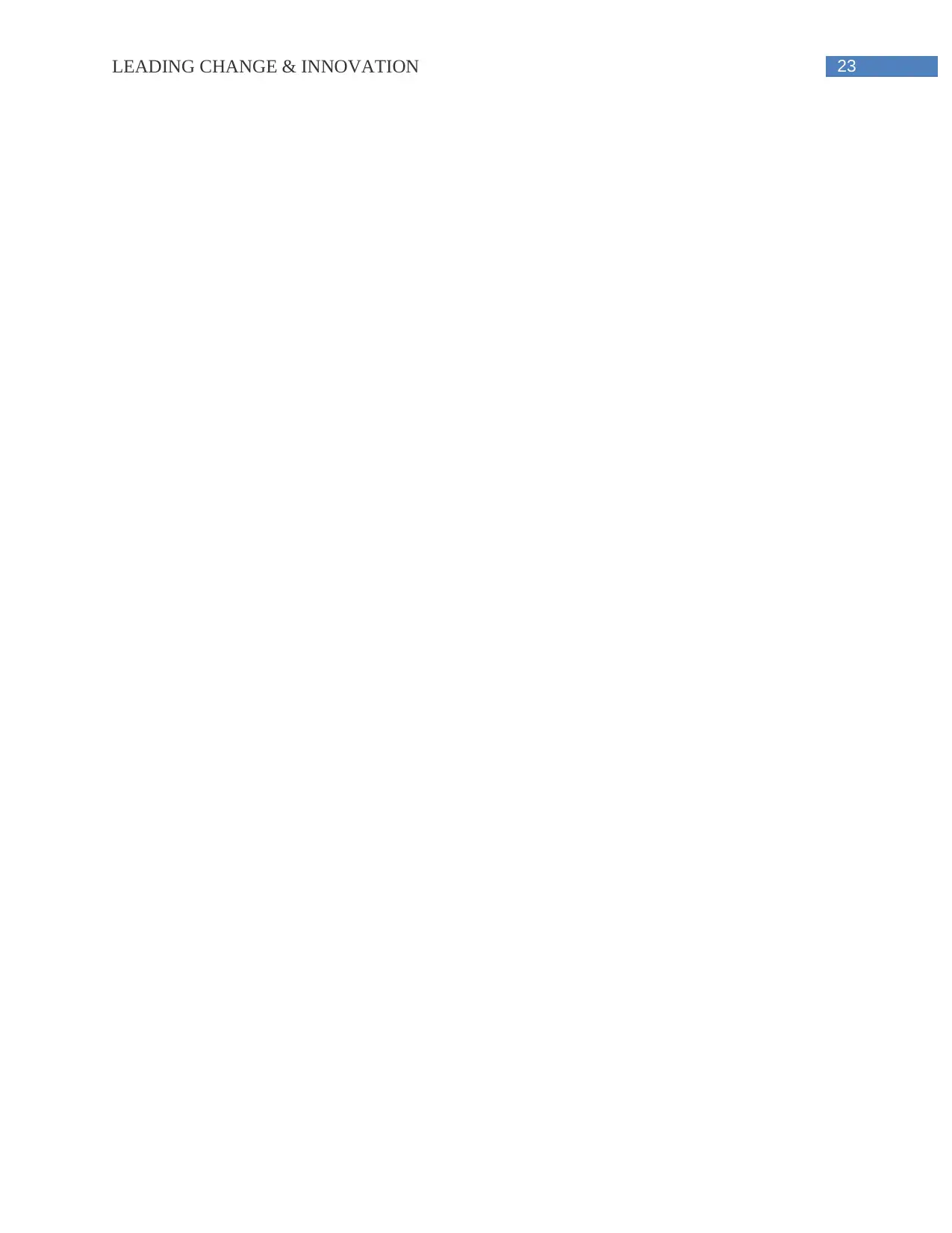
23LEADING CHANGE & INNOVATION
1 out of 24
Related Documents
Your All-in-One AI-Powered Toolkit for Academic Success.
+13062052269
info@desklib.com
Available 24*7 on WhatsApp / Email
![[object Object]](/_next/static/media/star-bottom.7253800d.svg)
Unlock your academic potential
© 2024 | Zucol Services PVT LTD | All rights reserved.





